American Revolutionary War
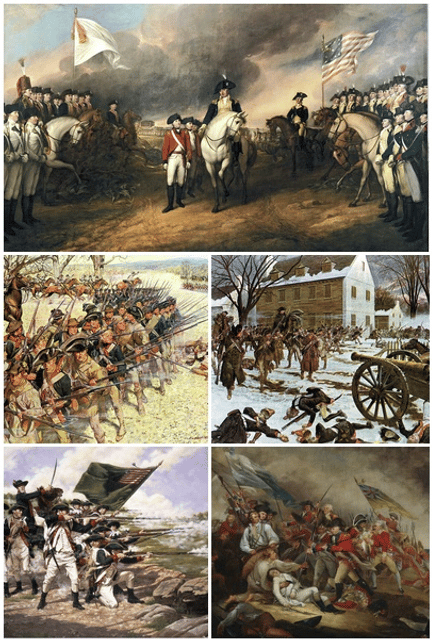
American Revolutionary War

| American Revolutionary War | |||||||||
|---|---|---|---|---|---|---|---|---|---|
| |||||||||
| Belligerents | |||||||||
(before 1776) (after 1776) French Empire[3][4] Spanish Empire[5] Co-belligerents:Dutch Republic[6] | Germans: | ||||||||
| Commanders and leaders | |||||||||
Louis XVI Charles III William V | |||||||||
| Strength | |||||||||
| United States: Army & Militia: 40,000 (average)[13] 200,000 (total served)[14] Navy: 5,000 sailors (peak 1779)[15] 53 frigates and sloops (total served)[15] State Navies: 106 ships (total served)[16] Privateers: 55,000 sailors (total served)[17] 1,697 ships[18]Allies: Army: 63,000 French and Spanish (Gibraltar)[19][20] Navy: 146 ships-of-the-line (1782)[21]American Indian Allies: Unknown | Great Britain: Army: 48,000 (America peak)[22] 121,000 (global 1781)[23] 7,500 (Gibraltar)[24] Navy: 94 ships-of-the-line (1782)[21] 104 frigates (1781)[25] 37 sloops (1781)[26] 171,000 sailors[27]Loyalists: 25,000 (total served)[28]Hanoverians: 2,365 (total served)[29]Germans: 29,875 (total served)[30]American Indian Allies: 13,000[31] | ||||||||
| Casualties and losses | |||||||||
| United States: 25,000–70,000 total dead[13][32] 6,800 killed in battle 17,000 died of disease[33] France: at least 7,000 dead (2,112 in the United States)[34] 19 ships of the line (1,346 guns) lost[35] 30 frigates (988 guns) lost[35]Spain: 5,000 dead[36] (124 in the American south)[37] 8 ships of the line (572 guns) lost[35] 11 frigates (326 guns) lost[35]Netherlands: 500 killed[36] Total: 37,000–82,500+ soldiers dead | Great Britain: Army: 43,633 total dead[38] ~9,372 killed in battle[39] 27,000 died of disease[13][40] Navy: 1,243 killed in battle 18,500 died of disease (1776–1780)[41] 42,000 deserted[42] 20 ships of the line (1,396 guns) lost[35] 70 frigates (1,978 guns) lost[35] 2,200 merchant ships (600 to American privateers) lost[35] 75 privateering ships lost[35]Germans: 7,774 total dead 1,800 killed in battle 4,888 deserted[13]Loyalists: 7,000 total dead 1,700 killed in battle 5,300 died of disease (estimated)[43] Total: 78,200+ soldiers dead | ||||||||
The American Revolutionary War (1775–1783), also known as the American War of Independence,[44] was an 18th-century war between Great Britain and its Thirteen Colonies which declared independence in 1776 as the United States of America, and then formed a military alliance with France in 1778.[1]
After 1765, growing constitutional and political differences strained the relationship between Great Britain and its colonies. Patriot protests against taxation without representation followed the Stamp Act and escalated into boycotts, which culminated in 1773 with the Sons of Liberty destroying a shipment of tea in Boston Harbor. Britain responded by closing Boston Harbor and passing a series of punitive measures against Massachusetts Bay Colony. Massachusetts colonists responded with the Suffolk Resolves, and they established a shadow government which wrested control of the countryside from the Crown. Twelve colonies formed a Continental Congress (with the exception of Georgia) to coordinate their resistance, establishing committees and conventions that effectively seized power.[45]
British attempts to disarm the Massachusetts militia in Concord led to open combat and a British defeat on April 19, 1775. Militia forces then besieged Boston, forcing a British evacuation in March 1776, and Congress appointed George Washington to command the Continental Army. Concurrently, the Americans failed decisively in an attempt to invade Quebec and raise insurrection against the British. On July 2, 1776, the Second Continental Congress voted for independence, issuing its declaration on July 4. Sir William Howe launched a British counter-offensive, capturing New York City and leaving American morale at a low ebb. However, victories at Trenton and Princeton restored American confidence. In 1777, the British launched an invasion from Quebec under John Burgoyne, intending to isolate the New England Colonies. Instead of assisting this effort, Howe took his army on a separate campaign against Philadelphia, and Burgoyne was decisively defeated at Saratoga in October 1777.
Burgoyne's defeat had drastic consequences. France formally allied with the Americans and entered the war in 1778, and Spain joined the war the following year as an ally of France but not as an ally of the United States. In 1780, the Kingdom of Mysore attacked the British in India, and tensions between Great Britain and the Netherlands erupted into open war. In North America, the British mounted a "Southern strategy" led by Charles Cornwallis which hinged upon a Loyalist uprising, but too few came forward. Cornwallis suffered reversals at King's Mountain and Cowpens. He retreated to Yorktown, Virginia, intending an evacuation, but a decisive French naval victory deprived him of an escape. A Franco-American army led by the Comte de Rochambeau and Washington then besieged Cornwallis' army and, with no sign of relief, he surrendered in October 1781.
Whigs in Britain had long opposed the pro-war Tories in Parliament, and the surrender gave them the upper hand. In early 1782, Parliament voted to end all offensive operations in America, but the war continued overseas. Britain remained under siege in Gibraltar but scored a major victory over the French navy. On September 3, 1783, the belligerent parties signed the Treaty of Paris in which Great Britain agreed to recognize the sovereignty of the United States and formally end the war. French involvement had proven decisive,[46] but France made few gains and incurred crippling debts. Spain made some territorial gains but failed in its primary aim of recovering Gibraltar.[47] The Dutch were defeated on all counts and were compelled to cede territory to Great Britain. In India, the war against Mysore and its allies concluded in 1784 without any territorial changes.
| American Revolutionary War | |||||||||
|---|---|---|---|---|---|---|---|---|---|
| |||||||||
| Belligerents | |||||||||
(before 1776) (after 1776) French Empire[3][4] Spanish Empire[5] Co-belligerents:Dutch Republic[6] | Germans: | ||||||||
| Commanders and leaders | |||||||||
Louis XVI Charles III William V | |||||||||
| Strength | |||||||||
| United States: Army & Militia: 40,000 (average)[13] 200,000 (total served)[14] Navy: 5,000 sailors (peak 1779)[15] 53 frigates and sloops (total served)[15] State Navies: 106 ships (total served)[16] Privateers: 55,000 sailors (total served)[17] 1,697 ships[18]Allies: Army: 63,000 French and Spanish (Gibraltar)[19][20] Navy: 146 ships-of-the-line (1782)[21]American Indian Allies: Unknown | Great Britain: Army: 48,000 (America peak)[22] 121,000 (global 1781)[23] 7,500 (Gibraltar)[24] Navy: 94 ships-of-the-line (1782)[21] 104 frigates (1781)[25] 37 sloops (1781)[26] 171,000 sailors[27]Loyalists: 25,000 (total served)[28]Hanoverians: 2,365 (total served)[29]Germans: 29,875 (total served)[30]American Indian Allies: 13,000[31] | ||||||||
| Casualties and losses | |||||||||
| United States: 25,000–70,000 total dead[13][32] 6,800 killed in battle 17,000 died of disease[33] France: at least 7,000 dead (2,112 in the United States)[34] 19 ships of the line (1,346 guns) lost[35] 30 frigates (988 guns) lost[35]Spain: 5,000 dead[36] (124 in the American south)[37] 8 ships of the line (572 guns) lost[35] 11 frigates (326 guns) lost[35]Netherlands: 500 killed[36] Total: 37,000–82,500+ soldiers dead | Great Britain: Army: 43,633 total dead[38] ~9,372 killed in battle[39] 27,000 died of disease[13][40] Navy: 1,243 killed in battle 18,500 died of disease (1776–1780)[41] 42,000 deserted[42] 20 ships of the line (1,396 guns) lost[35] 70 frigates (1,978 guns) lost[35] 2,200 merchant ships (600 to American privateers) lost[35] 75 privateering ships lost[35]Germans: 7,774 total dead 1,800 killed in battle 4,888 deserted[13]Loyalists: 7,000 total dead 1,700 killed in battle 5,300 died of disease (estimated)[43] Total: 78,200+ soldiers dead | ||||||||
Background
Taxation disputes
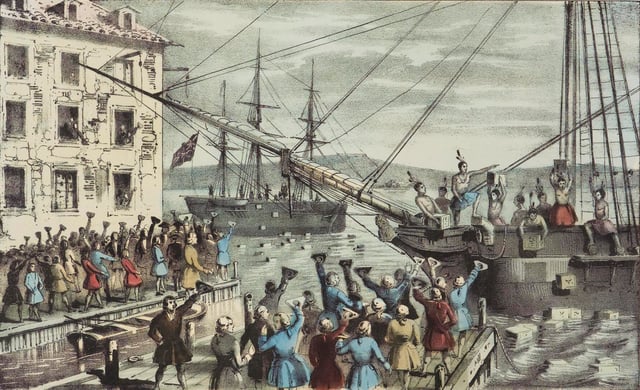
This iconic 1846 lithograph by Nathaniel Currier was entitled "The Destruction of Tea at Boston Harbor"; the phrase "Boston Tea Party" had not yet become standard. Contrary to Currier's depiction, few of the men dumping the tea were actually disguised as Indians.[54]
Parliament passed the Stamp Act in 1765 to pay for British military troops stationed in the American colonies after the French and Indian War. Parliament had previously passed legislation to regulate trade, but the Stamp Act introduced a new principle of a direct internal tax. Americans began to question the extent of the British Parliament's power in America, and the colonial legislatures argued that they had exclusive right to impose taxes within their jurisdictions.[48] Colonists condemned the tax because their rights as Englishmen protected them from being taxed by a Parliament in which they had no elected representatives.[49] Parliament argued that the colonies were "represented virtually", an idea that was criticized throughout the Empire.[50] Parliament did repeal the act in 1766, but it also affirmed its right to pass laws that were binding on the colonies.[51] From 1767, Parliament began passing legislation to raise revenue for the salaries of civil officials, ensuring their loyalty while inadvertently increasing resentment among the colonists, and opposition soon became widespread.[52][53]
Enforcing the acts proved difficult. The seizure of the sloop Liberty in 1768 on suspicions of smuggling triggered a riot. In response, British troops occupied Boston, and Parliament threatened to extradite colonists to face trial in England.[55] Tensions rose after the murder of Christopher Seider by a customs official in 1770 and escalated into outrage after British troops fired on civilians in the Boston Massacre.[56] In 1772, colonists in Rhode Island boarded and burned a customs schooner. Parliament then repealed all taxes except the one on tea, passing the Tea Act in 1773, attempting to force colonists to buy East India Company tea on which the Townshend duties were paid, thus implicitly agreeing to Parliamentary supremacy. The landing of the tea was resisted in all colonies, but the governor of Massachusetts permitted British tea ships to remain in Boston Harbor, so the Sons of Liberty destroyed the tea chests in what became known as the "Boston Tea Party".[57]
Parliament then passed punitive legislation. It closed Boston Harbor until the tea was paid for and revoked the Massachusetts Charter, taking upon themselves the right to directly appoint the Massachusetts Governor's Council. Additionally, the royal governor was granted powers to undermine local democracy.[58][59] Further measures allowed the extradition of officials for trial elsewhere in the Empire, if the governor felt that a fair trial could not be secured locally. The act's vague reimbursement policy for travel expenses left few with the ability to testify, and colonists argued that it would allow officials to harass them with impunity.[60] Further laws allowed the governor to billet troops in private property without permission.[61] The colonists referred to the measures as the "Intolerable Acts", and they argued that their constitutional rights and their natural rights were being violated, viewing the acts as a threat to all of America.[62] The acts were widely opposed, driving neutral parties into support of the Patriots and curtailing Loyalist sentiment.[63][64]
Colonial response
The colonists responded by establishing the Massachusetts Provincial Congress, effectively removing Crown control of the colony outside Boston. Meanwhile, representatives from twelve colonies[65][66] convened the First Continental Congress to respond to the crisis. The Congress narrowly rejected a proposal to create an American parliament to act in concert with the British Parliament; instead, they passed a compact declaring a trade boycott against Britain.[67][68] The Congress also affirmed that Parliament had no authority over internal American matters, but they were willing to consent to trade regulations for the benefit of the empire,[69] and they authorized committees and conventions to enforce the boycott. The boycott was effective, as imports from Britain dropped by 97% in 1775 compared to 1774.[68]
Parliament refused to yield. In 1775, it declared Massachusetts to be in a state of rebellion and enforced a blockade of the colony.[70][71] It then passed legislation to limit colonial trade to the British West Indies and the British Isles. Colonial ships were barred from the Newfoundland cod fisheries, a measure which pleased Canadiens but damaged New England's economy. These increasing tensions led to a mutual scramble for ordnance and pushed the colonies toward open war.[72] Thomas Gage was the British Commander-in-Chief and military governor of Massachusetts, and he received orders on April 14, 1775, to disarm the local militias.[73]
Course of the war
War breaks out (1775–1776)
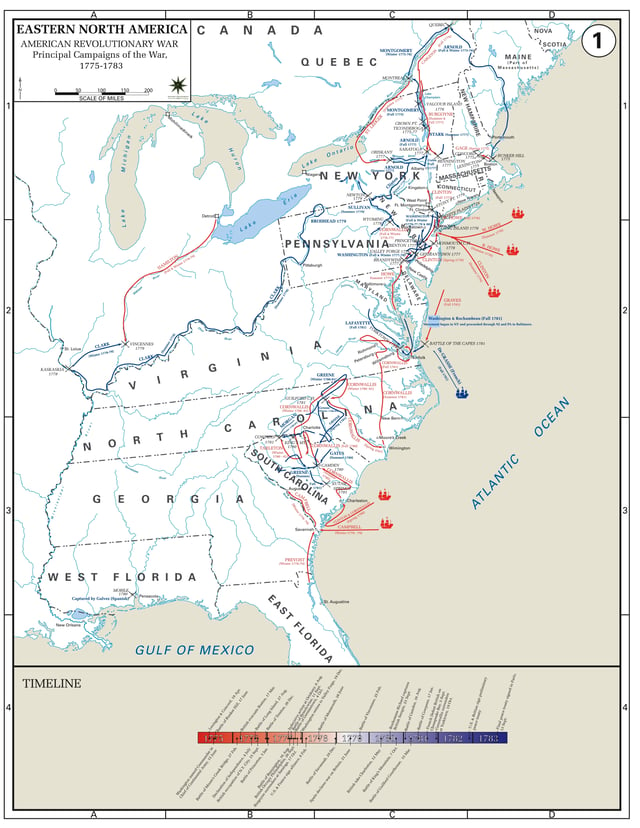
Major campaigns of the American Revolutionary War

The British marching to Concord

British soldiers and Provincial militiamen repulse the American assault at Sault-au-Matelot, Canada, December 1775
On April 18, 1775, 700 British troops were sent to confiscate militia ordnance stored at Concord.[74][75] Fighting broke out, forcing the troops to conduct a fighting withdrawal to Boston. Overnight, the local militia converged on and laid siege to Boston.[76] On May 25, 4,500 British reinforcements arrived with generals William Howe, John Burgoyne, and Henry Clinton.[77] The British seized the Charlestown peninsula on June 17 after a costly frontal assault,[78][79] leading Howe to replace Gage.[80] Many senior officers were dismayed at the attack, which had gained them little,[81] while Gage wrote to London stressing the need for a large army to suppress the revolt.[82] On July 3, George Washington took command of the Continental Army besieging Boston. Howe made no effort to attack, much to Washington's surprise.[83] A plan was rejected to assault the city,[84] and the Americans instead fortified Dorchester Heights in early March 1776 with heavy artillery captured from a raid on Fort Ticonderoga.[85] The British were permitted to withdraw unmolested on March 17, and they sailed to Halifax, Nova Scotia. Washington then moved his army to New York.[86]
Starting in August 1775, American Privateers began to raid villages in Nova Scotia, first at Saint John, then Charlottetown and Yarmouth. They continued in 1776 at Canso and then a land assault on Fort Cumberland.
Meanwhile, British officials in Quebec began lobbying Indian tribes to support them,[87] while the Americans urged them to maintain their neutrality.[88][89] In April 1775, Congress feared an Anglo-Indian attack from Canada and authorized an invasion of Quebec. Quebec had a largely Francophone population and had been under British rule for only 12 years,[90] and the Americans expected that they would welcome being liberated from the British.[91][92][93] The Americans attacked Quebec City on December 31 after an arduous march[94] but were defeated.[95][96] After a loose siege, the Americans withdrew on May 6. 1776.[97][98] A failed counter-attack on June 8 ended American operations in Quebec.[99] However, the British could not conduct an aggressive pursuit because of American ships on Lake Champlain. On October 11, the British defeated the American squadron, forcing them to withdraw to Ticonderoga and ending the campaign. The invasion cost the Patriots their support in British public opinion,[100] while aggressive anti-Loyalist policies diluted Canadian support.[101] The Patriots continued to view Quebec as a strategic aim, though no further attempts to invade were ever made.[102]
In Virginia, Royal governor Lord Dunmore had attempted to disarm the militia as tensions increased, although no fighting broke out.[103] He issued a proclamation on November 7, 1775, promising freedom for slaves who fled their Patriot masters to fight for the Crown.[104][105] Dunmore's troops were overwhelmed by Patriots at Great Bridge, and Dunmore fled to naval ships anchored off Norfolk. Subsequent negotiations broke down, so Dunmore ordered the ships to destroy the town.[106]
Fighting broke out on November 19 in South Carolina between Loyalist and Patriot militias,[107] and the Loyalists were subsequently driven out of the colony.[108] Loyalists were recruited in North Carolina to reassert colonial rule in the South, but they were decisively defeated and Loyalist sentiment was subdued.[109] A troop of British regulars set out to reconquer South Carolina and launched an attack on Charleston on June 28, 1776,[110] but it failed and effectively left the South in Patriot control until 1780.[111][112]
The shortage of gunpowder had led Congress to authorize an expedition against the Bahamas colony in the British West Indies in order to secure ordnance there.[113] On March 3, 1776, the Americans landed after a bloodless exchange of fire, and the local militia offered no resistance.[114] They confiscated all the supplies that they could load and sailed away on March 17.[115][116] The squadron reached New London, Connecticut on April 8, after a brief skirmish with the Royal Navy frigate HMS Glasgow on April 6.[117]
Political reactions
After fighting began, Congress launched a final attempt to avert war, which Parliament rejected as insincere.[118] King George then issued a Proclamation of Rebellion on August 23, 1775, which only served to embolden the colonists in their determination to become independent.[119] After a speech by the King, Parliament rejected coercive measures on the colonies by 170 votes.[120] British Tories refused to compromise,[121] while Whigs argued that current policy would drive the colonists towards independence.[122] Despite opposition, the King himself began micromanaging the war effort.[123] The Irish Parliament pledged to send troops to America,[124] and Irish Catholics were allowed to enlist in the army for the first time.[125] Irish Protestants favored the Americans, while Catholics favored the King.[126]
The initial hostilities provided a sobering military lesson for the British, causing them to rethink their views on colonial military capability.[127][128] The weak British response gave the Patriots the advantage, and the British lost control over every colony.[129] The army had been deliberately kept small in England since 1688 to prevent abuses of power by the King.[130] Parliament secured treaties with small German states for additional troops[131] and sent an army of 32,000 men to America after a year, the largest that it had ever sent outside Europe at the time.[132]
In the colonies, the success of Thomas Paine's pamphlet Common Sense had boosted public support for independence.[133][134] On July 2, Congress voted in favor of independence with twelve affirmatives and one abstention,[135] issuing its declaration on July 4.[136] Washington read the declaration to his men and the citizens of New York on July 9,[137] invigorating the crowd to tear down a lead statue of the King and melting it to make bullets.[138] British Tories criticized the signatories for not extending the same standards of equality to slaves.
Patriots followed independence with the Test Laws, requiring residents to swear allegiance to the state in which they lived,[139] intending to root out neutrals or opponents to independence. Failure to do so meant possible imprisonment, exile, or even death.[140] American Tories were barred from public office, forbidden from practising medicine and law, forced to pay increased taxes, or even barred from executing wills or becoming guardians to orphans.[141][142] Congress enabled states to confiscate Loyalist property to fund the war.[143] Some Quakers who remained neutral had their property confiscated. States later prevented Loyalists from collecting any debts that they were owed.[144]
British counter-offensive (1776–1777)
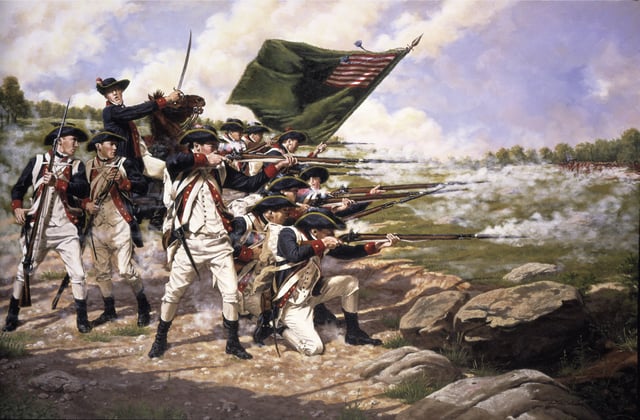
American soldiers in combat at the Battle of Long Island, 1776
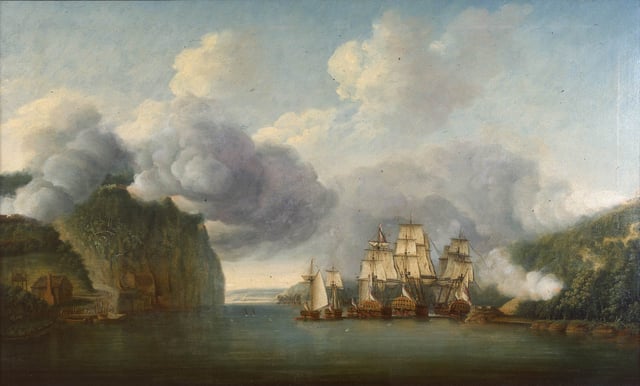
British warships forcing passage of the Hudson River
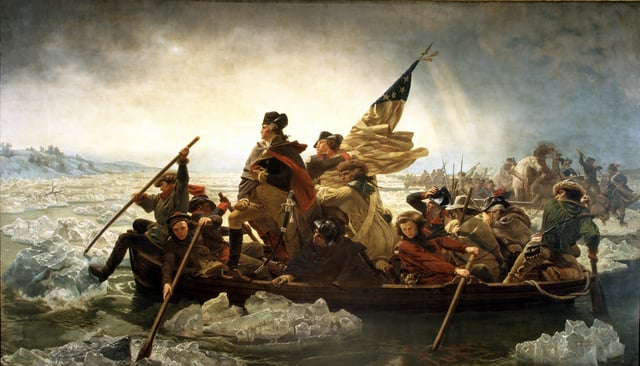
Emanuel Leutze's famous 1851 depiction of Washington Crossing the Delaware
After regrouping at Halifax, William Howe determined to take the fight to the Americans.[145] He set sail in June 1776 and began landing troops on Staten Island near the entrance to New York Harbor on July 2. Based on poor military intelligence, Washington split his army to positions on Manhattan Island and across the East River in western Long Island,[146] and an informal attempt to negotiate peace was rejected by the Americans.[147] On August 27, Howe outflanked Washington and forced him back to Brooklyn Heights. Howe restrained his subordinates from pursuit, opting to besiege Washington instead.[148]
Washington withdrew to Manhattan without any losses in men or ordnance.[149] Following the withdrawal, the Staten Island Peace Conference failed to negotiate peace, as the British delegates did not possess the authority to recognize independence.[150][151] Howe then seized control of New York City on September 15, and unsuccessfully engaged the Americans the following day.[152] He attempted to encircle Washington, but the Americans successfully withdrew. On October 28, the British fought an indecisive action against Washington, in which Howe declined to attack Washington's army, instead concentrating his efforts upon a hill that was of no strategic value.[153][154]
Washington's retreat left his forces isolated, and the British captured an American fortification on November 16, taking 3,000 prisoners and amounting to what one historian terms "the most disastrous defeat of the entire war".[155] Washington's army fell back four days later.[156] Henry Clinton then captured Newport, Rhode Island, an operation which he opposed, feeling that the 6,000 troops assigned to him could have been better employed in the pursuit of Washington.[157][158][159] The American prisoners were then sent to the infamous prison ships in which more American soldiers and sailors died of disease and neglect than died in every battle of the war combined.[160] Charles Cornwallis pursued Washington, but Howe ordered him to halt, and Washington marched away unmolested.[161][162]
The outlook of the American cause was bleak; the army had dwindled to fewer than 5,000 men and would be reduced further when the enlistments expired at the end of the year.[163] Popular support wavered, morale ebbed away, and Congress abandoned Philadelphia.[164] Loyalist activity surged in the wake of the American defeat, especially in New York.[142]
News of the campaign was well received in Britain. Festivities took place in London, public support reached a peak,[165][166] and the King awarded the Order of the Bath to William Howe. The successes led to predictions that the British could win within a year.[167] The American defeat revealed what one writer views as Washington's strategic deficiencies, such as dividing a numerically weaker army in the face of a stronger one, his inexperienced staff misreading the situation, and his troops fleeing in disorder when fighting began.[168] In the meantime, the British entered winter quarters and were in a good place to resume campaigning.[169]
On December 25, 1776, Washington stealthily crossed the Delaware River, and his army overwhelmed the Hessian (soldier) garrison at Trenton, New Jersey, the following morning, taking 900 prisoners.[170][171] The decisive victory rescued the army's flagging morale and gave a new hope to the cause for independence.[172] Cornwallis marched to retake Trenton, but his efforts were repulsed on January 2.[173][174] Washington outmanoeuvred Cornwallis that night, and defeated his rearguard the following day. The victories proved instrumental in convincing the French and Spanish that the Americans were worthwhile allies, as well as recovering morale in the army.[175][176][177] Washington entered winter quarters at Morristown, New Jersey, on January 6,[178] though a protracted guerrilla conflict continued.[179] While encamped, Howe made no attempt to attack, much to Washington's amazement.[180]
British northern strategy fails (1777–1778)

"The Surrender at Saratoga" shows General Daniel Morgan in front of a French de Vallière 4-pounder.
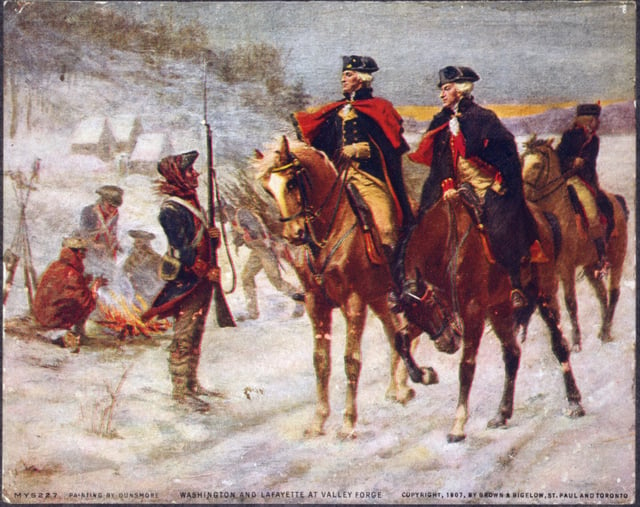
Washington and Lafayette inspect the troops at Valley Forge.
In December 1776, John Burgoyne returned to London to set strategy with Lord George Germain. Burgoyne's plan was to establish control of the Champlain-George-Hudson route from New York to Quebec, isolating New England. Efforts could then be concentrated on the southern colonies, where it was believed Loyalist support was in abundance.[181]
Burgoyne's plan was to lead an army along Lake Champlain, while a strategic diversion advanced along the Mohawk River, and both would rendezvous at Albany.[182] Burgoyne set out on June 14, 1777, quickly capturing Ticonderoga on July 5. Leaving 1,300 men behind as a garrison, Burgoyne continued the advance. Progress was slow; the Americans blocked roads, destroyed bridges, dammed streams and denuded the area of food.[183] Meanwhile, Barry St. Ledger's diversionary column laid siege to Fort Stanwix. St. Ledger withdrew to Quebec on August 22 after his Indian support abandoned him. On August 16, a Brunswick foraging expedition was soundly defeated at Bennington, and more than 700 troops were captured.[184] Meanwhile, the vast majority of Burgoyne's Indian support abandoned him and Howe informed Burgoyne he would launch his campaign on Philadelphia as planned, and would be unable to render aid.[185]
Burgoyne decided to continue the advance. On September 19, he attempted to flank the American position, and clashed at Freeman's Farm. The British won, but at the cost of 600 casualties. Burgoyne then dug in, but suffered a constant haemorrhage of deserters, and critical supplies were running low.[186] On October 7, a British reconnaissance in force against the American lines was repulsed with heavy losses. Burgoyne then withdrew with the Americans in pursuit, and by October 13, he was surrounded. With no hope of relief and supplies exhausted, Burgoyne surrendered on October 17, and 6,222 soldiers became prisoners of the Americans.[187] The decisive success spurred France to enter the war as an ally of the United States, securing the final elements needed for victory over Britain, that of foreign assistance.[188][189]
Meanwhile, Howe launched his campaign against Washington, though his initial efforts to bring him to battle in June 1777 failed.[190] Howe declined to attack Philadelphia overland via New Jersey, or by sea via the Delaware Bay, even though both options would have enabled him to assist Burgoyne if necessary. Instead, he took his army on a time-consuming route through the Chesapeake Bay, leaving him completely unable to assist Burgoyne. This decision was so difficult to understand, Howe's critics accused him of treason.[191]
Howe outflanked and defeated Washington on September 11, though he failed to follow-up on the victory and destroy his army.[192][193] A British victory at Willistown left Philadelphia defenceless, and Howe captured the city unopposed on September 26. Howe then moved 9,000 men to Germantown, north of Philadelphia.[194] Washington launched a surprise attack on Howe's garrison on October 4, which was eventually repulsed.[195] Again, Howe did not follow-up on his victory, leaving the American army intact and able to fight.[196] Later, after several days of probing American defences at White Marsh, Howe inexplicably ordered a retreat to Philadelphia, astonishing both sides.[197] Howe ignored the vulnerable American rear, where an attack could have deprived Washington of his baggage and supplies.[198] On December 19, Washington's army entered winter quarters at Valley Forge. Poor conditions and supply problems resulted in the deaths of some 2,500 troops.[199] Howe, only 20 miles (32 km) away, made no effort to attack, which critics observed could have ended the war.[200][201][202]
The Continental Army was put through a new training program, supervised by Baron von Steuben, introducing the most modern Prussian methods of drilling.[203] Meanwhile, Howe resigned and was replaced by Henry Clinton on May 24, 1778.[204] Clinton received orders to abandon Philadelphia and fortify New York following France's entry into the war. On June 18, the British departed Philadelphia, with the reinvigorated Americans in pursuit.[205] The two armies fought at Monmouth Court House on June 28, with the Americans holding the field, greatly boosting morale and confidence.[206] By July, both armies were back in the same positions they had been two years prior.
Foreign intervention
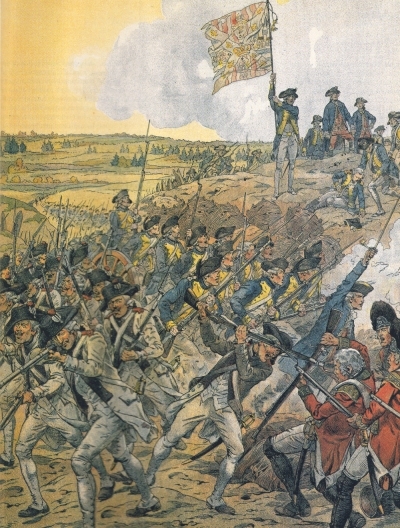
French troops storming Redoubt 9 during the Siege of Yorktown
The defeat at Saratoga caused considerable anxiety in Britain over foreign intervention. The North ministry sought reconciliation with the colonies by consenting to their original demands,[207] although Lord North refused to grant independence.[208] No positive reply was received from the Americans.[209]
French foreign minister the Comte de Vergennes was strongly anti-British,[210] and he sought a pretext for going to war with Britain following the conquest of Canada in 1763.[211] The French had covertly supplied the Americans through neutral Dutch ports since the onset of the war,[210] proving invaluable throughout the Saratoga campaign.[212][213][214] The French public favored war, though Vergennes and King Louis XVI were hesitant, owing to the military and financial risk.[215] The American victory at Saratoga convinced the French that supporting the Patriots was worthwhile,[216] but doing so also brought major concerns. The King was concerned that Britain's concessions would be accepted, and that Britain would then reconcile with the Colonies to strike at French and Spanish possessions in the Caribbean.[217][218] To prevent this, France formally recognized the United States on February 6, 1778, and followed with a military alliance. France aimed to expel Britain from the Newfoundland fishery, end restrictions on Dunkirk sovereignty, regain free trade in India, recover Senegal and Dominica, and restore the Treaty of Utrecht provisions pertaining to Anglo-French trade.[219][220]
Spain was wary of provoking war with Britain before being ready and opted to covertly supply the Patriots via its colonies in New Spain.[221][222] Congress hoped to persuade Spain into an open alliance, so the first American Commission met with the Count of Aranda in 1776.[223] Spain was still reluctant to make an early commitment, owing to a lack of direct French involvement, the threat against their treasure fleets, and the possibility of war with Portugal, Spain's neighbor and a close ally of Britain.[224] However, Spain affirmed its desire to support the Americans the following year, hoping to weaken Britain's empire.[225] The Portuguese threat was neutralized in the Spanish–Portuguese War (1776–77). On 12 April 1779, Spain signed the Treaty of Aranjuez with France and went to war against Britain.[226] Spain sought to recover Gibraltar and Menorca in Europe, as well as Mobile and Pensacola in Florida, and also to expel the British from Central America.[227][228]
Meanwhile, George III had given up on subduing America while Britain had a European war to fight.[229] He did not welcome war with France, but he believed that Britain had made all necessary steps to avoid it and cited the British victories over France in the Seven Years' War as a reason to remain optimistic.[230] Britain tried in vain to find a powerful ally to engage France, leaving it isolated,[231] preventing Britain from focusing the majority of her efforts in one theater,[232][233] and forcing a major diversion of military resources from America.[234][235] Despite this, the King determined never to recognize American independence and to ravage the colonies indefinitely, or until they pleaded to return to the yoke of the Crown.[236] Mahan argues that Britain's attempt to fight in multiple theaters simultaneously without major allies was fundamentally flawed, citing impossible mutual support, exposing the forces to defeat in detail.[237]
Since the outbreak of the conflict, Britain had appealed to her ally, the neutral Dutch Republic, to lend her the use of the Scots Brigade for service in America, but pro-American sentiment among the Dutch public forced them to deny the request.[238] Consequently, the British attempted to invoke several treaties for outright Dutch military support, but the Republic still refused. Moreover, American troops were being supplied with ordnance by Dutch merchants via their West Indies colonies.[239] French supplies bound for America had also passed through Dutch ports.[210] The Republic maintained free trade with France following France's declaration of war on Britain, citing a prior concession by Britain on this issue. Britain responded by confiscating Dutch shipping, and even firing upon it. Consequently, the Republic joined the First League of Armed Neutrality to enforce their neutral status.[240] The Republic had also given sanctuary to American privateers[241] and had drafted a treaty of commerce with the Americans. Britain argued that these actions contravened the Republic's neutral stance and declared war in December 1780.[242]
International war breaks out (1778–1780)
Europe
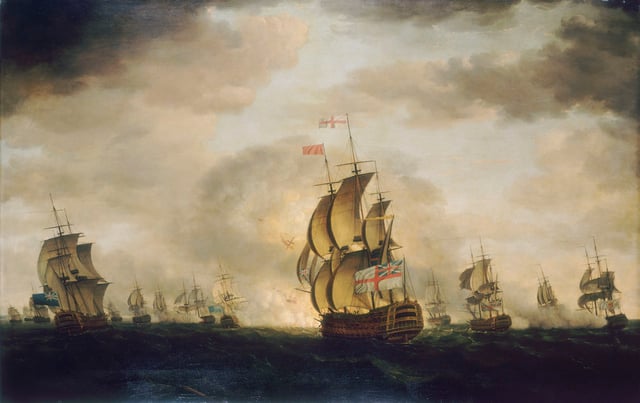
The Moonlight Battle of Cape St. Vincent, 16 January 1780 by Francis Holman, painted 1780
Soon after France declared war, French and British fleets fought an indecisive action off Ushant on July 27, 1778.[243] Spain entered the war on April 12, 1779 with a primary goal of capturing Gibraltar,[244] and Spanish troops under the Duc de Crillon laid siege to the Rock on June 24.[245] The naval blockade, however, was relatively weak, and the British were able to resupply the garrison.[246] Meanwhile, a plan was formulated for a combined Franco-Spanish invasion of the British mainland, but the expedition failed because of poor planning, disease, logistical issues, and high financial expenditures.[247][248] However, a diversionary Franco-American squadron did meet with some success on September 23 under John Paul Jones.[249] On 16 January 1780, the Royal Navy under George Rodney scored a major victory over the Spanish, weakening the naval blockade of Gibraltar.[250]
A Franco-Spanish fleet commanded by Luis de Córdova intercepted and decisively defeated a large British convoy off the Azores led by John Moutray on August 9 which was bound for the West Indies.[251] The defeat was catastrophic for Britain, which lost 52 merchant ships[252][253] and five East Indiamen,[254][255] as well as supplies and crews,[256] making it one of the most complete naval captures ever made.[257] The loss was valued at some £1.5 million (£181 million in today's money), dealing a severe blow to British commerce.[258][259]
Americas
The French blockaded the lucrative sugar islands of Barbados and Jamaica, intending to damage British trade.[260] French troops led by the Marquis de Bouillé captured Dominica on September 7, 1778, in order to improve communication among French Caribbean islands and to strike a blow against privateering.[261][262] The British defeated a French naval force on December 15 and captured St. Lucia on December 28.[263] Both fleets received reinforcements through the first half of 1779, but the French under the Comte d'Estaing had superiority in the Caribbean and began capturing British territories,[264] seizing St. Vincent on June 18 and Grenada on July 4.[265] The British fleet under John Byron was tactically defeated on July 6, having pursued d'Estaing from Grenada,[266] the worst loss that the Royal Navy had suffered since 1690.[267] Naval skirmishes continued until April 17, 1780, when British and French fleets clashed indecisively off Martinique.
General Bernardo de Gálvez raised an army in New Orleans and drove the British out of the Gulf of Mexico. He captured five British forts in the Lower Mississippi Valley, and they repelled a British and Indian attack in St. Louis, Missouri and captured the British fort of St. Joseph in Niles, Michigan. He received reinforcements from Cuba, Mexico, and Puerto Rico, then captured Mobile and Pensacola, the capital of the British colony of West Florida.[268] At Pensacola, Gálvez commanded a multinational army of more than 7,000 black and white soldiers born in Spain, Cuba, Mexico, Puerto Rico, Santo Domingo, and other Spanish colonies such as Venezuela.[269]
In Central America, the defense of Guatemala was a priority for Spain. The British intended to capture the key fortress of San Fernando de Omoa and drive the Spanish from the region.[270] After inadequate first attempts, 1,200 British troops led by William Dalrymple arrived on October 16, and they captured the fort on October 20.[271] However, the British suffered terribly from disease and were forced to abandon the fort on November 29,[272] and Spanish troops subsequently reoccupied it.[273] In 1780, Jamaica's governor John Dalling planned an expedition to cut New Spain in two by capturing Granada, which would allow them full control of the San Juan River.[274] A British expedition set out on February 3, 1780, led by John Polson and Horatio Nelson.[275] They reached Fort San Juan on March 17 and laid siege, capturing it on April 29.[276] The British were ravaged by disease[277] and were running low on food because of poor logistics.[275] They withdrew on November 8, the expedition having suffered a decisive defeat;[278] some 2,500 troops had perished, making it the costliest British disaster of the war.[279]
India
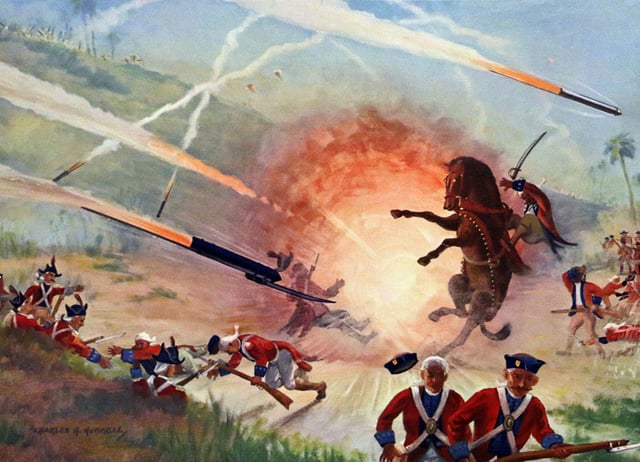
Mysorean troops defeat the British at Pollilur, using rockets against closely massed British infantry
The British East India Company moved quickly to capture French possessions in India when they learned about the hostilities with France, and they took Pondicherry on 19 October 1778 after a two-week siege.[280] The Company resolved to drive the French completely out of India,[281] and they captured the Malabar port of Mahé in 1779[282] through which French ordnance passed.
Mahé was under the protection of Mysore's ruler Hyder Ali (the Tipu Sultan), and tensions were already inflamed because the British had supported Malabar rebels who had risen against him;[283] so the fall of Mahé precipitated war.[284] Hyder Ali invaded the Carnatic region in July 1780 and laid siege to Tellicherry and Arcot. A British relief force of 7,000 men[285] under William Baille was intercepted and destroyed by the Tipu Sultan on 10 September, the worst defeat suffered by a European army in India at the time.[286]
Ali then renewed the siege at Arcot instead of pressing on for a decisive victory against a second British army at Madras, capturing it on 3 November. The delay allowed British forces to regroup for campaigning the following year.[287]
Stalemate in the North (1778–1780)
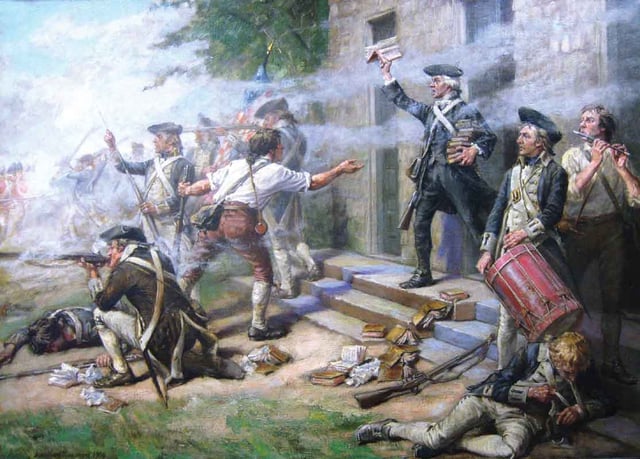
"Give 'em Watts, boys!" – American troops repulse Wilhelm von Knyphausen's attack at Springfield
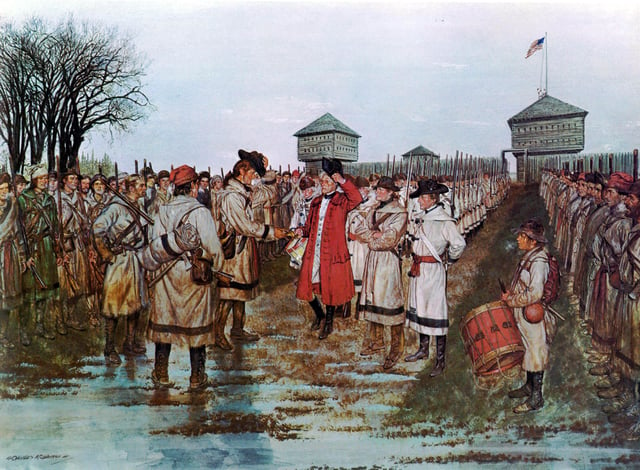
Hamilton surrenders at Vincennes, February 29, 1779
Henry Clinton withdrew from Philadelphia, consolidating his forces in New York following the British defeat at Saratoga and the entry of France into the war.[235] French admiral the Comte d'Estaing had been dispatched to America in April 1778 to assist Washington, and he arrived shortly after Clinton withdrew into New York.[288] The Franco-American forces felt that New York's defenses were too formidable for the French fleet,[289] and they opted to attack Newport.[290] This effort was launched on August 29, but it failed when the French opted to withdraw, and this displeased the Americans.[291] The war then ground down to a stalemate, with the majority of actions fought as large skirmishes, such as those at Chestnut Neck and Little Egg Harbor. In the summer of 1779, the Americans captured British posts at Stony Point and Paulus Hook.[292][293]
In July, Clinton unsuccessfully attempted to coax Washington into a decisive engagement by making a major raid into Connecticut.[294] That month, a large American naval operation attempted to retake Maine, but it resulted in the worst American naval defeat until Pearl Harbor in 1941.[295] The high frequency of Iroquois raids compelled Washington to mount a punitive expedition which destroyed a large number of Iroquois settlements, but the effort ultimately failed to stop the raids.[296][297] During the winter of 1779–80, the Continental Army suffered greater hardships than at Valley Forge.[298] Morale was poor, public support was being eroded by the long war, the national currency was virtually worthless, the army was plagued with supply problems, desertion was common, and whole regiments mutinied over the conditions in early 1780.[299]
In 1780, Clinton launched an attempt to retake New Jersey. On June 7, 6,000 men invaded under Hessian general Wilhelm von Knyphausen, but they met stiff resistance from the local militia. The British held the field, but Knyphausen feared a general engagement with Washington's main army and withdrew.[300] Knyphausen and Clinton decided upon a second attempt two weeks later which was soundly defeated at Springfield, effectively ending British ambitions in New Jersey.[301] Meanwhile, American general Benedict Arnold turned traitor and joined the British army, and he conspired to betray the key American fortress of West Point by surrendering it to the enemy.[302] The plot was foiled when British spy master John André was captured, so Arnold fled to British lines in New York. He attempted to justify his betrayal by appealing to Loyalist public opinion, but the Patriots strongly condemned him as a coward and turncoat.[303]
The war to the west of the Appalachians was largely confined to skirmishing and raids. An expedition of militia was halted by adverse weather in February 1778 after it set out to destroy British military supplies in settlements along the Cuyahoga River.[304] Later in the year, a second campaign was undertaken to seize the Illinois Country from the British. The Americans captured Kaskaskia on July 4 and then secured Vincennes, although Vincennes was recaptured by Henry Hamilton, the British commander at Detroit. In early 1779, the Americans counter-attacked by undertaking a risky winter march, and they secured the surrender of the British at Vincennes, taking Hamilton prisoner.[305][306]
On May 25, 1780, the British launched an expedition into Kentucky as part of a wider operation to clear resistance from Quebec to the Gulf coast. The expedition met with only limited success, though hundreds of settlers were killed or captured.[307] The Americans responded with a major offensive along the Mad River in August which met with some success, but it did little to abate the Indian raids on the frontier.[308] French militia attempted to capture Detroit, but it ended in disaster when Miami Indians ambushed and defeated the gathered troops on November 5.[309] The war in the west had become a stalemate; the Americans did not have the manpower to simultaneously defeat the hostile Indian tribes and occupy the land.[310]
War in the South (1778–1781)

British troops besiege Charleston in 1780, by Alonzo Chappel
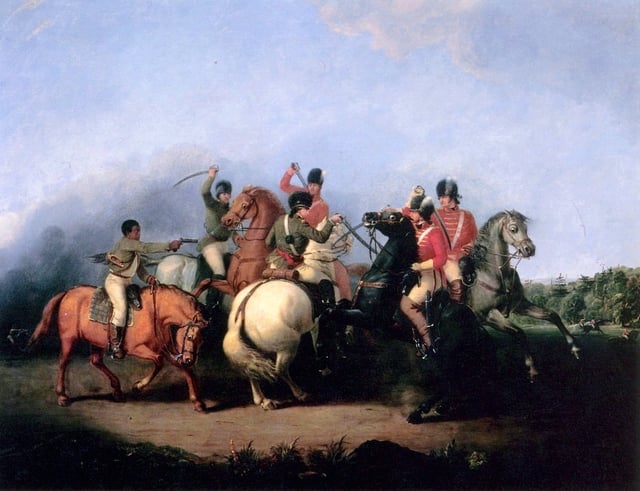
American and British cavalry clash at the Battle of Cowpens; from an 1845 painting by William Ranney
The British turned their attention to conquering the South in 1778 after Loyalists in London assured them of a strong Loyalist base there. A southern campaign also had the advantage of keeping the Royal Navy closer to the Caribbean, where it would be needed to defend lucrative colonies against the Franco-Spanish fleets.[311] On December 29, 1778, an expeditionary corps from New York captured Savannah, and British troops then moved inland to recruit Loyalist support.[312] There was a promising initial turnout in early 1779, but then a large Loyalist militia was defeated at Kettle Creek on February 14 and they had to recognize their dependence upon the British. The British, however, defeated Patriot militia at Brier Creek on March 3,[313] and then launched an abortive assault on Charleston, South Carolina. The operation became notorious for its high degree of looting by British troops, enraging both Loyalists and Patriots.[314]
In October, a combined Franco-American effort failed to recapture Savannah. In May 1780, Henry Clinton captured Charleston, taking over 5,000 prisoners and effectively destroying the Continental Army in the south. Organized American resistance in the region collapsed when Banastre Tarleton defeated the withdrawing Americans at Waxhaws on May 29.[315]
Clinton returned to New York, leaving Charles Cornwallis in command in Charleston to oversee the southern war effort. Far fewer Loyalists joined him than expected. In the interim, the war was carried on by Patriot militias who effectively suppressed Loyalists by winning victories in Fairfield County, Lincolnton, Huck's Defeat, Stanly County, and Lancaster County.
The British launched a surprise offensive in Virginia in January 1781, with Benedict Arnold invading Richmond, Virginia to little resistance. Governor Thomas Jefferson escaped Richmond just ahead of the British forces, and the British burned the city to the ground.[316][317] Jefferson sent an emergency dispatch to Colonel Sampson Mathews whose militia was traveling nearby, to thwart Arnold's efforts.[318][319]
Congress appointed Horatio Gates, victor at Saratoga, to lead the American effort in the south. He suffered a major defeat at Camden on August 16, 1780, setting the stage for Cornwallis to invade North Carolina.[320] The British attempted to subjugate the countryside, and Patriot militia continued to fight against them, so Cornwallis dispatched troops to raise Loyalist forces to cover his left flank as he moved north.[321] This wing of Cornwallis' army was virtually destroyed on October 7, irreversibly breaking Loyalist support in the Carolinas. Cornwallis subsequently aborted his advance and retreated back into South Carolina.[322] In the interim, Washington replaced Gates with his trusted subordinate Nathanael Greene.[323]
Greene was unable to confront the British directly, so he dispatched a force under Daniel Morgan to recruit additional troops. Morgan then defeated the cream of the British army under Tarleton on January 17, 1781 at Cowpens. Cornwallis was criticized for having detached a substantial part of his army without adequate support,[324] but he advanced into North Carolina despite the setbacks, gambling that he would receive substantial Loyalist support there. Greene evaded combat with Cornwallis, instead wearing the British down through a protracted war of attrition.[325]
By March, Greene's army had increased in size enough that he felt confident in facing Cornwallis. The two armies engaged at Guilford Courthouse on March 15; Greene was beaten, but Cornwallis' army suffered irreplaceable casualties.[326] Compounding this, far fewer Loyalists were joining than the British had previously expected.[327] Cornwallis' casualties were such that he was compelled to retreat to Wilmington for reinforcement, leaving the Patriots in control of the interior of the Carolinas and Georgia.
Greene then proceeded to reclaim the South. The American troops suffered a reversal at Hobkirk's Hill on April 25;[328] nonetheless, they continued to dislodge strategic British posts in the area, capturing Fort Watson[329] and Fort Motte.[330] Augusta was the last major British outpost in the South outside of Charleston and Savannah, but the Americans reclaimed possession of it on June 6.[331] A British force clashed with American troops at Eutaw Springs on September 8 in a final effort to stop Greene, but the British casualties were so high that they withdrew to Charleston.[332] Minor skirmishes continued in the Carolinas until the end of the war, and British troops were effectively confined to Charleston and Savannah for the remainder of the conflict.[333]
British defeat in America (1781)
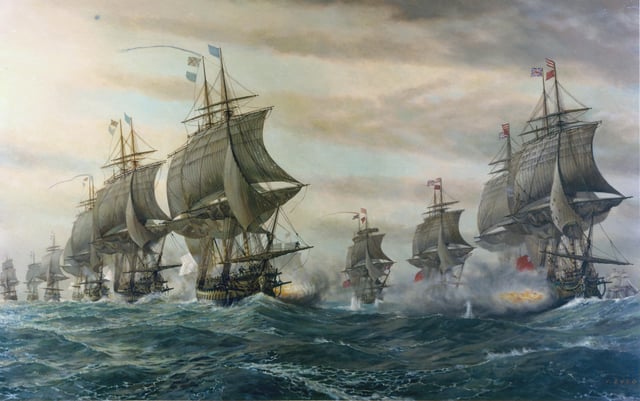
The French (left) and British (right) lines exchange fire at the Battle of the Chesapeake

Surrender of Cornwallis at Yorktown by John Trumbull, 1797
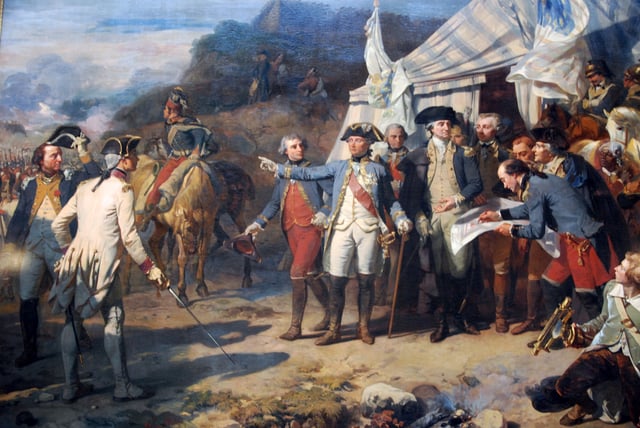
Washington and the Comte de Rochambeau at Yorktown, 1781
Cornwallis had discovered that the majority of American supplies in the Carolinas were passing through Virginia, and he had written to both Lord Germain and Clinton detailing his intentions to invade. Cornwallis believed that a successful campaign there would cut supplies to Greene's army and precipitate a collapse of American resistance in the South. Clinton strongly opposed the plan, favoring a campaign farther north in the Chesapeake Bay region.[334] Lord Germain wrote to Cornwallis to approve his plan and neglected to include Clinton in the decision-making, even though Clinton was Cornwallis' superior officer,[335] and Cornwallis then decided to move into Virginia without informing Clinton.[336] Clinton, however, had failed to construct a coherent strategy for British operations in 1781,[337] owing to his difficult relationship with his naval counterpart Marriot Arbuthnot.[338]
Following the calamitous operations at Newport and Savannah, French planners realized that closer cooperation with the Americans was required to achieve success.[339] The French fleet led by the Comte de Grasse had received discretionary orders from Paris to assist joint efforts in the north if naval support was needed.[340][341] Washington and the Comte de Rochambeau discussed their options. Washington pushed for an attack on New York, while Rochambeau preferred a strike in Virginia, where the British were less well-established and thus easier to defeat.[342] Franco-American movements around New York caused Clinton a great deal of anxiety, fearing an attack on the city. His instructions were vague to Cornwallis during this time, rarely forming explicit orders. However, Clinton did instruct Cornwallis to establish a fortified naval base and to transfer troops to the north to defend New York.[343] Cornwallis dug in at Yorktown and awaited the Royal Navy.[344]
Washington still favored an assault on New York, but he acquiesced to the French when they opted to send their fleet to their preferred target of Yorktown. In August, the combined Franco-American army moved south to coordinate with de Grasse in defeating Cornwallis.[345] The British lacked sufficient naval resources to effectively counter the French, but they dispatched a fleet under Thomas Graves to assist Cornwallis and attempt to gain naval dominance.[346] On September 5, the French fleet decisively defeated Graves, giving the French control of the seas around Yorktown and cutting off Cornwallis from reinforcements and relief.[347] Despite the continued urging of his subordinates,[348] Cornwallis made no attempt to break out and engage the Franco-American army before it had established siege works, expecting that reinforcements would arrive from New York, and the Franco-American army laid siege to Yorktown on September 28.[349] Cornwallis continued to think that relief was imminent from Clinton, and he abandoned his outer defenses which were immediately occupied by American troops—serving to hasten his subsequent defeat.[350] The British then failed in an attempt to break out of the siege across the river at Gloucester Point when a storm hit.[351] Cornwallis and his subordinates were under increasing bombardment and facing dwindling supplies; they agreed that their situation was untenable and negotiated a surrender on October 17, 1781,[352] and 7,685 soldiers became prisoners of the Americans.[353] The same day as the surrender, 6,000 troops under Clinton had departed New York, sailing to relieve Yorktown.[354][355]
North Ministry collapses
On 25 November 1781, news arrived in London of the surrender at Yorktown. The Whig opposition gained traction in Parliament, and a motion was proposed on December 12 to end the war which was defeated by only one vote. On 27 February 1782, the House voted against further war in America by 19 votes.[356]
Lord Germain was dismissed and a vote of no confidence was passed against North. The Rockingham Whigs came to power and opened negotiations for peace. Rockingham died and was succeeded by the Earl of Shelburne. Despite their defeat, the British still had 30,000 troops garrisoned in New York, Charleston, and Savannah.[357] Henry Clinton was recalled and was replaced by Guy Carleton who was under orders to suspend offensive operations.[358]
Final years of the war (1781–1783)
Europe
After hostilities with the Dutch began in late 1780, Britain had moved quickly, enforcing a blockade across the North Sea. Within weeks, the British had captured 200 Dutch merchantmen, and 300 more were holed up in foreign ports,[359] though political turmoil within the Republic[360] and peace negotiations by both sides helped keep conflict to a minimum.[361] The majority of the Dutch public favored a military alliance with France against Britain; however, the Dutch Stadtholder impeded these efforts, hoping to secure an early peace.[362] To restore diminishing trade[363] a Dutch squadron under Johan Zoutman escorted a fleet of some 70 merchantmen from the Texel. Zoutman's ships were intercepted by Sir Hyde Parker, who engaged Zoutman at Dogger Bank on 5 August 1781. Though the contest was tactically inconclusive, the Dutch fleet did not leave harbor again during the war, and their merchant fleet remained crippled.[364]
On 6 January 1781, a French attempt to capture Jersey to neutralize British privateering failed.[365] Frustrated in their attempts to capture Gibraltar, a Franco-Spanish force of 14,000 men under the Duc de Mahon invaded Minorca on 19 August. After a long siege of St. Philip's, the British garrison under James Murray surrendered on 5 February 1782,[366] securing a primary war goal for the Spanish.[367] At Gibraltar, a major Franco-Spanish assault on 13 September 1782 was repulsed with heavy casualties.[368] On 20 October 1782, following a successful resupply of Gibraltar, British ships under Richard Howe successfully refused battle to the Franco-Spanish fleet under Luis de Córdova, denying Córdova dominance at sea.[369][370] On 7 February 1783, after 1,322[371] days of siege, the Franco-Spanish army withdrew, decisively defeated.[372][373]
Americas
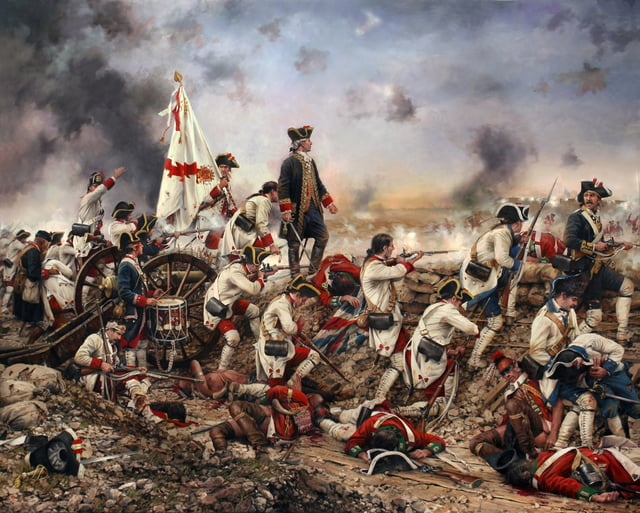
Spanish troops led by Bernardo de Gálvez in combat at Pensacola. Oil on canvas, Augusto Ferrer-Dalmau, 2015.
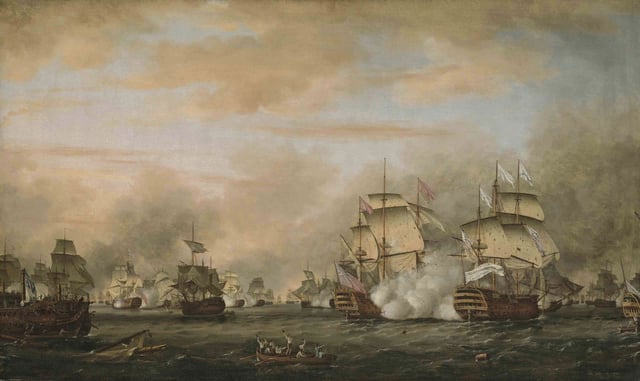
Battle of the Saintes, 12 April 1782 – Admiral George Rodney defeats the Comte De Grasse in the West Indies. Oil on canvas by Thomas Whitcombe
After the fall of Mobile to Spanish troops under Bernardo de Gálvez, an attempt to capture Pensacola was thwarted by a hurricane. Emboldened by the disaster, John Campbell, British commander at Pensacola, decided to recapture Mobile.[376] Campbell's expeditionary force of around 700 men was defeated on 7 January 1781.[377] After re-grouping at Havana, Gálvez set out for Pensacola on 13 February.[378] Arriving on 9 March, siege operations did not begin until 24 March, owing to difficulties in bringing the ships into the bay.[379] After a 45-day siege, Gálvez decisively defeated the garrison, securing the conquest of West Florida.[380] In May, Spanish troops captured the Bahamas,[381] although the British bloodlessly recaptured the islands the following year on 18 April.[382]
In the West Indies, on 29–30 April 1781, a Royal Navy squadron under Samuel Hood was narrowly defeated by the French, led by the Comte de Grasse,[383] who continued seizing British territories: Tobago fell on 2 June;[384] Demerara and Essequibo on 22 January 1782;[385] St. Kitts and Nevis on 12 February,[386] despite a British naval victory on 25 January;[387] and Montserrat on 22 February.[388]
In 1782, the primary strategic goal of the French and Spanish was the capture of Jamaica,[389] whose sugar exports were more valuable to the British than the Thirteen Colonies combined.[390][391] On 7 April 1782, de Grasse departed Martinique to rendezvous with Franco-Spanish troops at Saint Domingue and invade Jamaica from the north.[392] The British under Hood and George Rodney pursued and decisively defeated the French off Dominica between 9–12 April.[393][394] The Franco-Spanish plan to conquer Jamaica was in ruins,[395] and the balance of naval power in the Caribbean shifted to the Royal Navy.[396]
In Guatemala, Matías de Gálvez led Spanish troops in an effort to dislocate British settlements along the Gulf of Honduras.[397] Gálvez captured Roatán on 16 March 1782, and then quickly took Black River.[398] Following the decisive naval victory at the Saintes,[399] Archibald Campbell, the Royal governor of Jamaica, authorized Edward Despard to re-take Black River,[400] which he did on 22 August.[401] However, with peace talks opening, and Franco-Spanish resources committed to the siege of Gibraltar, no further offensive operations took place.[401]
India
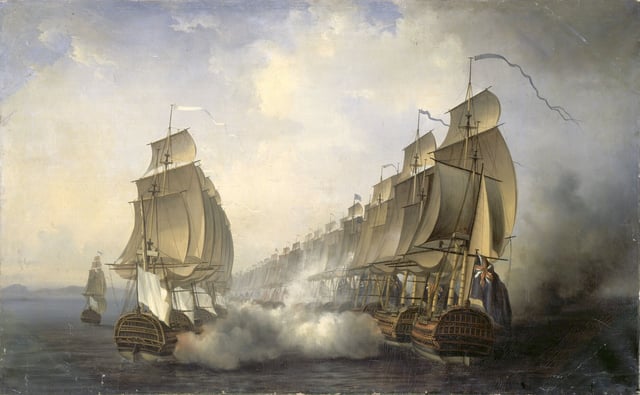
The British (right) and the French (left), with Admiral Suffren's flagship Cléopâtre on the far left, exchange fire at Cuddalore, by Auguste Jugelet, 1836.
In March 1781, French Admiral Bailli de Suffren was dispatched to India to assist colonial efforts. Suffren arrived off the Indian coast in February 1782, where he clashed with a British fleet under Hughes, winning a narrow tactical victory.[404] After landing troops at Porto Novo to assist Mysore, Suffren's fleet clashed with Hughes again Providien on 12 April. There was no clear victor, though Hughes' fleet came off worse,[405] and he withdrew to the British-held port of Trincomalee. Hyder Ali wished for the French to capture Negapatam to establish naval dominance over the British, and this task fell to Suffren. Suffren's fleet clashed with Hughes again off Negapatam on 6 July.[406] Suffren withdrew to Cuddalore, strategically defeated, and the British remained in control of Negapatam.[407][408] Intending to find a more suitable port than Cuddalore, Suffren captured Trincomalee on 1 September, and successfully engaged Hughes two days later.[409]
Meanwhile, Ali's troops loosely blockaded Vellore as the East India Company regrouped.[410] Company troops under Sir Eyre Coote led a counter-offensive, defeating Ali at Porto Novo on 1 July 1781,[411] Pollilur on 27 August,[412] and Sholinghur on 27 September, expelling the Mysorean troops from the Carnatic.[413][414] On 18 February 1782, Tipu Sultan defeated John Braithwaite near Tanjore, taking his entire 1,800-strong force prisoner.[415] The war had, by this point, reached an uneasy stalemate.[416] On 7 December 1782, Hyder Ali died,[417] and the rule of Mysore passed to his son, Tipu Sultan.[418]
Sultan advanced along the west coast, laying siege to Mangalore on 20 May 1783.[419] Meanwhile, on the east coast, an army under James Stuart besieged the French-held port of Cuddalore on 9 June 1783.[420] On 20 June, key British naval support for the siege was neutralized when Suffren defeated Hughes' fleet off Cuddalore,[421] and though narrow, the victory gave Suffren the opportunity to displace British holdings in India.[422] On 25 June, the Franco-Mysorean defenders made repeated sorties against British lines, though all assaults failed. On 30 June, news arrived of a preliminary peace between the belligerent powers, and the siege was effectively over when the French abandoned the siege.[423] Mangalore remained under siege, and capitulated to Sultan on 30 January 1784.[424] Little fighting took place thereafter, and Mysore and Britain made peace on 11 March.[415]
Peace of Paris

Benjamin West's painting of the American delegations at the Treaty of Paris. The British delegation refused to pose, and the painting was never completed.

Washington enters New York in triumph following the British evacuation of America.
Following the surrender at Yorktown, the Whig party came to power in Britain and began opening negotiations for a cessation of hostilities. While peace negotiations were being undertaken, British troops in America were restricted from launching further offensives.[358] Prime Minister the Earl of Shelburne was reluctant to accept American independence as a prerequisite for peace, as the British were aware that the French economy was nearly bankrupt, and reinforcements sent to the West Indies could potentially reverse the situation there. He preferred that the colonies accept Dominion status within the Empire, though a similar offer had been rejected by the Americans in 1778.[425] Negotiations soon began in Paris.
The Americans initially demanded that Quebec be ceded to them as spoils of war, a proposal that was dropped when Shelburne accepted American demands for recognition of independence. On April 19, 1782, the Dutch formally recognized the United States as a sovereign power, enhancing American leverage at the negotiations. Spain initially impeded the negotiations, refusing to enter into peace talks until Gibraltar had been captured. The Comte de Vergennes proposed that American territory be confined to the east of the Appalachians; Britain would have sovereignty over the area north of the Ohio River, below which an Indian barrier state would be established under Spanish control. The United States fiercely opposed the proposal.[426]
The Americans skirted their allies, recognizing that more favorable terms would be found in London. They negotiated directly with Shelburne, who hoped to make Britain a valuable trading partner of America at the expense of France. To this end, Shelburne offered to cede all the land east of the Mississippi River, north of Florida, and south of Quebec,[427] while also allowing American fishermen access to the rich Newfoundland fishery.[428] Shelburne was hoping to facilitate the growth of the American population, creating lucrative markets that Britain could exploit at no administrative cost to London. As Vergennes commented, "the English buy peace rather than make it".[429]
Throughout the negotiations, Britain never consulted her American Indian allies, forcing them to reluctantly accept the treaty. However, the subsequent tension erupted into conflicts between the Indians and the young United States, the largest being the Northwest Indian War.[430] Britain continued trying to create an Indian buffer state in the American Midwest as late as 1814 during the War of 1812.[431][432]
Britain negotiated separate treaties with Spain, France, and the Dutch Republic.[433] Gibraltar proved to be a stumbling block in the peace talks; Spain offered to relinquish their conquests in West Florida, Menorca, and the Bahamas[434] in exchange for Gibraltar, terms which Shelburne steadfastly refused. Shelburne instead offered to cede East Florida, West Florida, and Menorca if Spain would relinquish the claim on Gibraltar, terms which were reluctantly accepted.[435] However, in the long-term, the new territorial gains were of little value to Spain.[436] France's only net gains were the island of Tobago in the Caribbean and Senegal in Africa, after agreeing to return all other colonial conquests to British sovereignty.[437] Britain returned Dutch Caribbean territories to Dutch sovereignty, in exchange for free trade rights in the Dutch East Indies[438][439] and control of the Indian port of Negapatnam.[440]
Preliminary peace articles were signed in Paris on 30 November 1782, while preliminaries between Britain, Spain, France, and the Netherlands continued until September 1783. The United States Congress of the Confederation ratified the Treaty of Paris on January 14, 1784. Copies were sent back to Europe for ratification by the other parties involved, the first reaching France in March 1784. British ratification occurred on April 9, 1784, and the ratified versions were exchanged in Paris on May 12, 1784.[441] The war formally concluded on September 3, 1783.[442]
The last British troops departed New York City on November 25, 1783, marking the end of British rule in the new United States.[443]
Aftermath
Casualties and losses
Americans and allies
The total loss of life throughout the conflict is largely unknown. As was typical in wars of the era, diseases such as smallpox claimed more lives than battle. Between 1775 and 1782, a smallpox epidemic broke out throughout North America, killing 40 people in Boston alone. Historian Joseph Ellis suggests that Washington's decision to have his troops inoculated against the disease was one of his most important decisions.[444]
Between 25,000 and 70,000 American Patriots died during active military service.[32] Of these, approximately 6,800 were killed in battle, while at least 17,000 died from disease. The majority of the latter died while prisoners of war of the British, mostly in the prison ships in New York Harbor.[33] If the upper limit of 70,000 is accepted as the total net loss for the Patriots, it would make the conflict proportionally deadlier than the American Civil War.[13] Uncertainty arises from the difficulties in accurately calculating the number of those who succumbed to disease, as it is estimated at least 10,000 died in 1776 alone.[13] The number of Patriots seriously wounded or disabled by the war has been estimated from 8,500 to 25,000.[445]
The French suffered approximately 7,000 total dead throughout the conflict; of those, 2,112 were killed in combat in the American theaters of war.[34]
The Dutch suffered around 500 total killed, owing to the minor scale of their conflict with Britain.[36]
British and allies
British returns in 1783 listed 43,633 rank and file deaths across the British Armed Forces.[38] A table from 1781 puts total British Army deaths at 9,372 soldiers killed in battle across the Americas; 6,046 in North America (1775–1779), and 3,326 in the West Indies (1778–1780).[39] In 1784, a British lieutenant compiled a detailed list of 205 British officers killed in action during the war, encompassing Europe, the Caribbean and the East Indies.[446] Extrapolations based upon this list puts British Army losses in the area of at least 4,000 killed or died of wounds.[13] Approximately 7,774 Germans died in British service in addition to 4,888 deserters; of the former, it is estimated 1,800 were killed in combat.[13]
Around 171,000 sailors served in the Royal Navy during the war; approximately a quarter of whom had been pressed into service. Around 1,240 were killed in battle, while an estimated 18,500 died from disease (1776–1780).[41] The greatest killer at sea was scurvy, a disease caused by vitamin C deficiency.[447] It was not until 1795 that scurvy was eradicated from the Royal Navy after the Admiralty declared lemon juice and sugar were to be issued among the standard daily rations of sailors.[448] Around 42,000 sailors deserted during the war.[449] The impact on merchant shipping was substantial; an estimated 3,386 merchant ships were seized by enemy forces during the war;[450] of those, 2,283 were taken by American privateers alone.[451]
Financial debts
At the start of the war, the economy of the colonies was flourishing,[452] and the free white population enjoyed the highest standard of living in the world.[453] The Royal Navy enforced a naval blockade during the war to financially cripple the colonies, however, this proved unsuccessful; 90% of the population worked in farming, not in coastal trade, and, as such, the American economy proved resilient enough to withstand the blockade.[454]
Congress had immense difficulties throughout the conflict to efficiently finance the war effort.[455] As the circulation of hard currency declined, the Americans had to rely on loans from American merchants and bankers, France, Spain and the Netherlands, saddling the young nation with crippling debts. Congress attempted to remedy this by printing vast amounts of paper money and bills of credit to raise revenue. The effect was disastrous; inflation skyrocketed, and the paper money became virtually worthless. The inflation spawned a popular phrase that anything of little value was "not worth a continental".[456]
By 1791, the United States had accumulated a national debt of approximately $75.5 million.[457] The United States finally solved its debt and currency problems in the 1790s, when Secretary of the Treasury Alexander Hamilton secured legislation by which the national government assumed all of the state debts, and, in addition, created a national bank and a funding system based on tariffs and bond issues that paid off the foreign debts.[458]
Britain spent around £80 million and ended with a national debt of £250 million, (£27.1 billion in today's money), generating a yearly interest of £9.5 million annually. The debts piled upon that which it had already accumulated from the Seven Years' War.[459] Wartime taxation upon the British populace averaged approximately four shilling in every pound, or 20 percent.[460]
The French spent approximately 1.3 billion livres equivalent to 100 million pounds sterling (13.33 livres to the pound) on aiding the Americans,[461] accumulating a national debt of 3.315.1 billion livres by 1783 on war costs.[462] Unlike Britain, which had a very efficient taxation system,[463] while the French tax system was grossly inefficient which eventually leading to a financial crisis in 1786.[464] The debts contributed to a worsening fiscal crisis that ultimately begat the French Revolution at the end of the century.[465] The debt continued to spiral; on the eve of the French Revolution, the national debt had skyrocketed to 12 billion livres.[466]
Spain had nearly doubled her military spending during the war, from 454 million reales in 1778 to over 700 million in 1779.[467] Spain more easily disposed of her debts unlike her French ally, partially as a result of the massive increase in silver mining in her American colonies; production increased approximately 600% in Mexico, and by 250% in Peru and Bolivia.[468]
Analysis of combatants
Great Britain

British redcoats at the Battle of Bunker Hill in 1775
The population of Great Britain and Ireland in 1780 was approximately 12.6 million,[469] while the Thirteen Colonies held a population of some 2.8 million, including some 500,000 slaves.[470] Theoretically, Britain had the advantage, however, many factors inhibited the procurement of a large army.
Armed forces
Recruitment
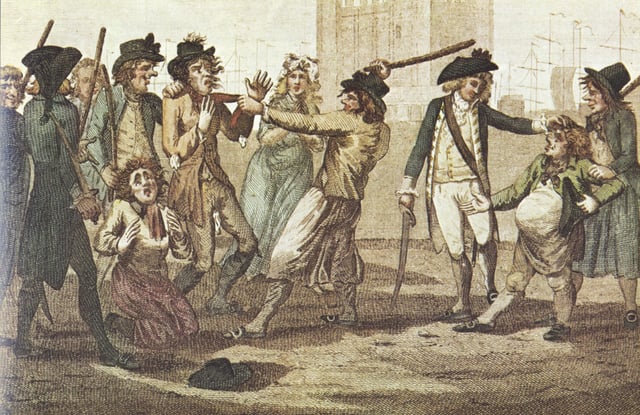
Press gang at work, British caricature of 1780
In 1775, the standing British Army, exclusive of militia, comprised 45,123 men worldwide, made up of 38,254 infantry and 6,869 cavalry. The Army had approximately eighteen regiments of foot, some 8,500 men, stationed in North America.[471] Standing armies had played a key role in the purge of the Long Parliament in 1648,[472] the maintenance of a military dictatorship under Oliver Cromwell,[473] and the overthrow of James II,[474] and, as such, the Army had been deliberately kept small in peacetime to prevent abuses of power by the King.[130][475] Despite this, eighteenth century armies were not easy guests, and were regarded with scorn and contempt by the press and public of the New and Old World alike, derided as enemies of liberty. An expression ran in the Navy; "A messmate before a shipmate, a shipmate before a stranger, a stranger before a dog, a dog before a soldier".[476]
Parliament suffered chronic difficulties in obtaining sufficient manpower,[477] and found it impossible to fill the quotas they had set.[478] The Army was a deeply unpopular profession, one contentious issue being pay. A Private infantryman was paid a wage of just 8d. per day,[479] the same pay as for a New Model Army infantryman, 130 years earlier.[480] The rate of pay in the army was insufficient to meet the rising costs of living, turning off potential recruits,[481] as service was nominally for life.[482]
To entice people to enrol, Parliament offered a bounty of £1.10s for every recruit.[483] As the war dragged on, Parliament became desperate for manpower; criminals were offered military service to escape legal penalties, and deserters were pardoned if they re-joined their units.[484] After the defeat at Saratoga, Parliament doubled the bounty to £3,[485] and increased it again the following year, to £3.3s, as well as expanding the age limit from 17–45 to 16–50 years of age.[486]
Impressment, essentially conscription by the "press gang", was a favored recruiting method, though it was unpopular with the public, leading many to enlist in local militias to avoid regular service.[487] Attempts were made to draft such levies, much to the chagrin of the militia commanders.[488] Competition between naval and army press gangs, and even between rival ships or regiments, frequently resulted in brawls between the gangs in order to secure recruits for their unit.[489] Men would maim themselves to avoid the press gangs,[490] while many deserted at the first opportunity.[491] Pressed men were militarily unreliable; regiments with large numbers of such men were deployed to garrisons such as Gibraltar or the West Indies, purely to increase the difficulty in successfully deserting.[492]
By 1781, the Army numbered approximately 121,000 men globally,[23] 48,000 of whom were stationed throughout the Americas.[22] Of the 171,000 sailors[27] who served in the Royal Navy throughout the conflict, around a quarter were pressed. This same proportion, approximately 42,000 men, deserted during the conflict.[42] At its height, the Navy had 94 ships-of-the-line,[493] 104 frigates[494] and 37 sloops[495] in service.
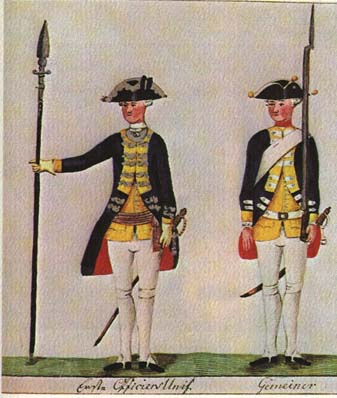
Hessian soldiers of the Leibregiment
In 1775, Britain unsuccessfully attempted to secure 20,000 mercenaries from Russia,[496] and the use of the Scots Brigade from the Dutch Republic,[497] such was the shortage of manpower. Parliament managed to negotiate treaties with the princes of German states for large sums of money, in exchange for auxiliary troops.[131] In total, 29,875 troops were hired for British service from six German states; Brunswick (5,723), Hesse-Kassel (16,992), Hesse-Hannau (2,422), Ansbach-Bayreuth (2,353), Waldeck-Pyrmont (1,225) and Anhalt-Zerbst (1,160).[30] King George III, who also ruled Hanover as a Prince-elector of the Holy Roman Empire, was approached by Parliament to lend the government Hanoverian soldiers for service in the war. Hanover supplied 2,365 men in five battalions, however, the lease agreement permitted them to only be used in Europe.[498]
Without any major allies,[231] the manpower shortage became critical when France and Spain entered the war, forcing a major diversion of military resources from the Americas.[234][235] Recruiting adequate numbers of Loyalist militia in America was made difficult by intensive Patriot activity.[499] To bolster numbers, the British promised freedom and grants of land to slaves who fought for them.[500] Approximately 25,000 Loyalists fought for the British throughout the war,[28] and provided some of the best troops in the British service;[501] the British Legion, a mixed regiment of 250 dragoons and 200 infantry[502] commanded by Banastre Tarleton, gained a fearsome reputation in the colonies, especially in the South.[503][504][505]
Leadership
Britain had a difficult time appointing a determined senior military leadership in America. Thomas Gage, Commander-in-Chief of North America at the outbreak of the war, was criticized for being too lenient on the rebellious colonists. Jeffrey Amherst, who was appointed Commander-in-Chief of the Forces in 1778, refused a direct command in America, because he was unwilling to take sides in the war.[506] Admiral Augustus Keppel similarly opposed a command, stating; "I cannot draw the sword in such a cause". The Earl of Effingham resigned his commission when his regiment was posted to America, while William Howe and John Burgoyne were opposed to military solutions to the crisis. Howe and Henry Clinton both stated they were unwilling participants, and were only following orders.[507]
As was the case in many European armies, except the Prussian Army, officers in British service could purchase commissions to ascend the ranks.[508] Despite repeated attempts by Parliament to suppress it, the practise was common in the Army.[509] Values of commissions varied, but were usually in line with social and military prestige, for example, regiments such as the Guards commanded the highest prices.[510] The lower ranks often regarded the treatment to high-ranking commissions by wealthier officers as "plums for [their] consumption".[511] Wealthy individuals lacking any formal military education, or practical experience, often found their way into positions of high responsibility, diluting the effectiveness of a regiment.[512] Though Royal authority had forbade the practise since 1711, it was still permitted for infants to hold commissions. Young boys, often orphans of deceased wealthy officers, were taken from their schooling and placed in positions of responsibility within regiments.[513]
Logistics
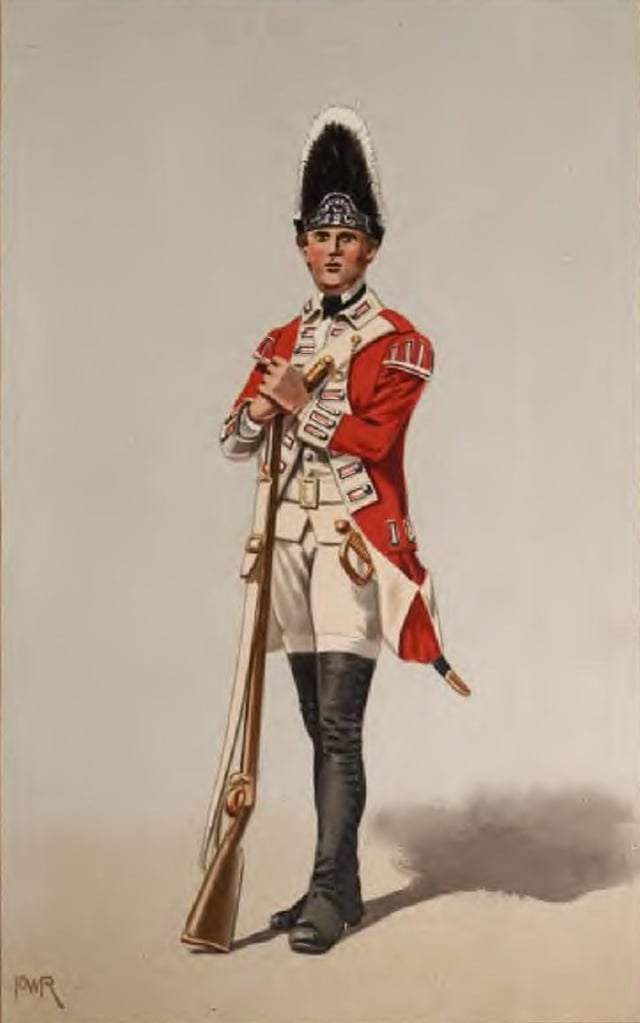
Grenadier of the 40th Regiment of Foot in 1767, armed with a Brown Bess musket
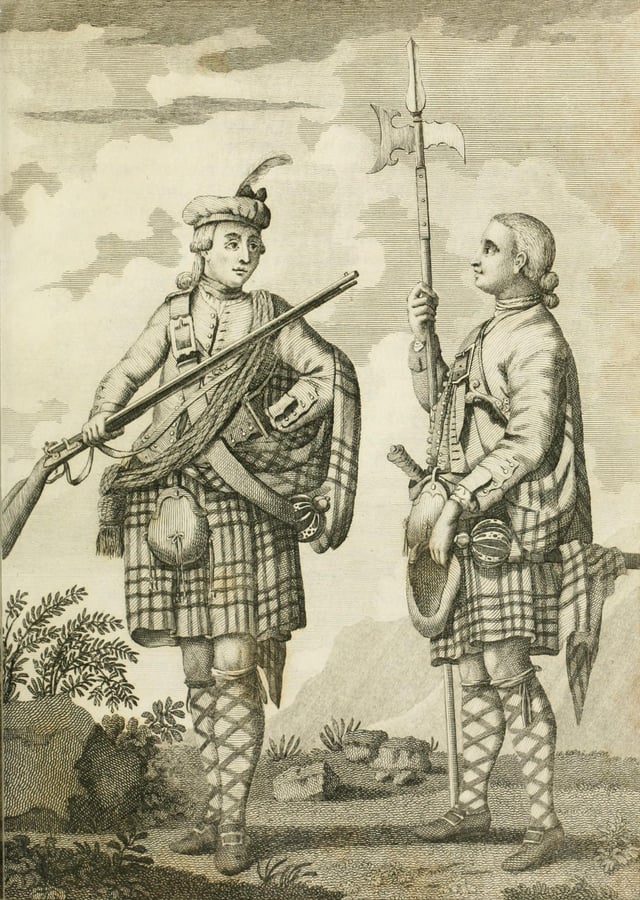
Soldiers of the Black Watch armed with Brown Bess muskets, c. 1790
Logistical organization of eighteenth century armies was chaotic at best, and the British Army was no exception. No logistical corps existed in the modern sense; while on campaign in foreign territories such as America, horses, wagons, and drivers were frequently requisitioned from the locals, often by impressment or by hire.[514] No centrally organized medical corps existed. It was common for surgeons to have no formal medical education, and no diploma or entry examination was required. Nurses sometimes were apprentices to surgeons, but many were drafted from the women who followed the army.[515] Army surgeons and doctors were poorly paid and were regarded as social inferiors to other officers.[516]
The heavy personal equipment and wool uniform of the regular infantrymen were wholly unsuitable for combat in America, and the outfit was especially ill-suited to comfort and agile movement.[517] During the Battle of Monmouth in late June 1778, the temperature exceeded 100°F (37.8°C) and is said to have claimed more lives through heat stroke than through actual combat.[518] The standard-issue firearm of the British Army was the Land Pattern Musket. Some officers preferred their troops to fire careful, measured shots (around two per minute), rather than rapid firing. A bayonet made firing difficult, as its cumbersome shape hampered ramming down the charge into the barrel.[519] British troops had a tendency to fire impetuously, resulting in inaccurate fire, a trait for which John Burgoyne criticized them during the Saratoga campaign. Burgoyne instead encouraged bayonet charges to break up enemy formations, which was a preferred tactic in most European armies at the time.[520]
Every battalion in America had organized its own rifle company by the end of the war, although rifles were not formally issued to the army until the Baker Rifle in 1801.[521] Flintlocks were heavily dependent on the weather; high winds could blow the gunpowder from the flash pan,[522] while heavy rain could soak the paper cartridge, ruining the powder and rendering the musket unable to fire. Furthermore, flints used in British muskets were of notoriously poor quality; they could only be fired around six times before requiring resharpening, while American flints could fire sixty. This led to a common expression among the British: "Yankee flint was as good as a glass of grog".[523]
Provisioning troops and sailors proved to be an immense challenge, as the majority of food stores had to be shipped overseas from Britain.[524] The need to maintain Loyalist support prevented the Army from living off the land.[525] Other factors also impeded this option; the countryside was too sparsely populated and the inhabitants were largely hostile or indifferent, the network of roads and bridges was poorly developed, and the area which the British controlled was so limited that foraging parties were frequently in danger of being ambushed.[526] After France entered the war, the threat of the French navy increased the difficulty of transporting supplies to America. Food supplies were frequently in bad condition. The climate was also against the British in the southern colonies and the Caribbean, where the intense summer heat caused food supplies to sour and spoil.[527]
Life at sea was little better. Sailors and passengers were issued a daily food ration, largely consisting of hardtack and beer.[528] The hardtack was often infested by weevils and was so tough that it earned the nicknames "molar breakers" and "worm castles",[529] and it sometimes had to be broken up with cannon shot. Meat supplies often spoiled on long voyages.[530] The lack of fresh fruit and vegetables gave rise to scurvy, one of the biggest killers at sea.[447]
Discipline
Discipline was harsh in the armed forces, and the lash was used to punish even trivial offences—and not used sparingly.[531] For instance, two redcoats received 1,000 lashes each for robbery during the Saratoga campaign,[532] while another received 800 lashes for striking a superior officer.[533] Flogging was a common punishment in the Royal Navy and came to be associated with the stereotypical hardiness of sailors.[534]
Despite the harsh discipline, a distinct lack of self-discipline pervaded all ranks of the British forces. Soldiers had an intense passion for gambling, reaching such excesses that troops would often wager their own uniforms.[535] Many drank heavily, and this was not exclusive to the lower ranks; William Howe was said to have seen many "crapulous mornings" while campaigning in New York. John Burgoyne drank heavily on a nightly basis towards the end of the Saratoga campaign. The two generals were also reported to have found solace with the wives of subordinate officers to ease the stressful burdens of command.[536] During the Philadelphia campaign, British officers deeply offended local Quakers by entertaining their mistresses in the houses where they had been quartered.[537] Some reports indicated that British troops were generally scrupulous in their treatment of non-combatants.[538] This is in contrast to diaries of Hessian soldiers, who recorded their disapproval of British conduct towards the colonists, such as the destruction of property and the execution of prisoners.[539]
The presence of Hessian soldiers caused considerable anxiety among the colonists, both Patriot and Loyalist, who viewed them as brutal mercenaries.[540] British soldiers were often contemptuous in their treatment of Hessian troops, despite orders from General Howe that "the English should treat the Germans as brothers". The order only began to have any real effect when the Hessians learned to speak a minimal degree of English, which was seen as a prerequisite for the British troops to accord them any respect.[541]
During peacetime, the Army's idleness led to it being riddled with corruption and inefficiency, resulting in many administrative difficulties once campaigning began.[542]
Strategic deficiencies
The British leadership soon discovered it had overestimated the capabilities of its own troops, while underestimating those of the colonists, causing a sudden re-think in British planning.[127][128] The ineffective initial response of British military and civil officials to the onset of the rebellion had allowed the advantage to shift to the colonists, as British authorities rapidly lost control over every colony.[129] A microcosm of these shortcomings were evident at the Battle of Bunker Hill. It took ten hours for the British leadership to respond following the sighting of the Americans on the Charlestown Peninsula, giving the colonists ample time to reinforce their defenses.[543] Rather than opt for a simple flanking attack that would have rapidly succeeded with minimal loss,[544] the British decided on repeated frontal attacks. The results were telling; the British suffered 1,054 casualties of a force of around 3,000 after repeated frontal assaults.[545] The British leadership had nevertheless remained excessively optimistic, believing that just two regiments could suppress the rebellion in Massachusetts.[546][547]
Debate persists over whether a British defeat was a guaranteed outcome. Ferling argues that the odds were so long, the defeat of Britain was nothing short of a miracle.[548] Ellis, however, considers that the odds always favored the Americans, and questions whether a British victory by any margin was realistic. Ellis argues that the British squandered their only opportunities for a decisive success in 1777, and that the strategic decisions undertaken by William Howe underestimated the challenges posed by the Americans. Ellis concludes that, once Howe failed, the opportunity for a British victory "would never come again".[549] Conversely, the United States Army's official textbook argues that, had Britain been able to commit 10,000 fresh troops to the war in 1780, a British victory was within the realms of possibility.[550]
William Howe
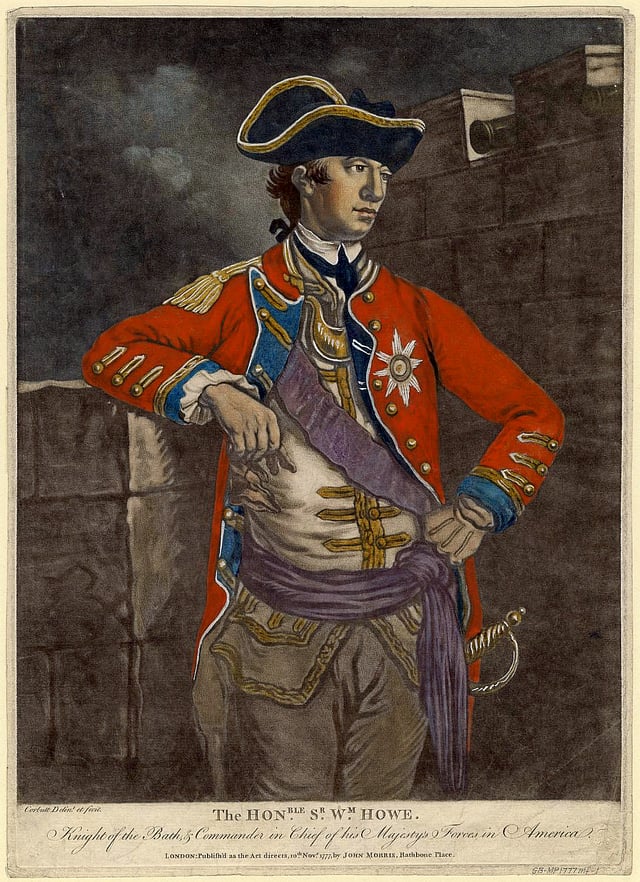
A 1777 mezzotint of Sir William Howe, British Commander-in-Chief from 1775–1778
Historians such as Ellis and Stewart have observed that, under William Howe's command, the British squandered several opportunities to achieve a decisive victory over the Americans.[550][549] Throughout the New York and Philadelphia campaigns, Howe made several strategic errors, errors which cost the British opportunities for a complete victory. At Long Island, Howe failed to even attempt an encirclement of Washington,[551] and actively restrained his subordinates from mounting an aggressive pursuit of the defeated American army.[148] At White Plains, he refused to engage Washington's vulnerable army, and instead concentrated his efforts upon a hill which offered the British no strategic advantage.[153][154] After securing control of New York, Howe dispatched Henry Clinton to capture Newport, a measure which Clinton was opposed to, on the grounds the troops assigned to his command could have been put to better use in pursuing Washington's retreating army.[157][158][159] Despite the bleak outlook for the revolutionary cause[552] and the surge of Loyalist activity in the wake of Washington's defeats,[142] Howe made no attempt to mount an attack upon Washington while the Americans settled down into winter quarters, much to their surprise.[180]
During planning for the Saratoga campaign, Howe was left with the choice of committing his army to support Burgoyne, or capture Philadelphia, the revolutionary capital. Howe decided upon the latter, determining that Washington was of a greater threat. When Howe launched his campaign, he took his army upon a time-consuming route through the Chesapeake Bay, rather than the more sensible choices of overland through New Jersey, or by sea through the Delaware Bay. The move left him unable to assist Burgoyne even if it was required of him. The decision so angered Parliament, that Howe was accused by Tories on both sides of the Atlantic of treason.[191]
During the Philadelphia campaign, Howe failed to pursue and destroy the defeated Americans on two occasions; once after the Battle of Brandywine,[192][193] and again after the Battle of Germantown.[196] At the Battle of White Marsh, Howe failed to even attempt to exploit the vulnerable American rear,[198] and then inexplicably ordered a retreat to Philadelphia after only minor skirmishes, astonishing both sides.[197] While the Americans wintered only twenty miles away, Howe made no effort to attack their camp, which critics argue could have ended the war.[200][201][202] Following the conclusion of the campaign, Howe resigned his commission, and was replaced by Henry Clinton on May 24, 1778.[204]
Contrary to Howe's more hostile critics, however, there were strategic factors at play which impeded aggressive action. Howe may have been dissuaded from pursuing aggressive manoeuvres by the memory of the grievous losses the British suffered at Bunker Hill.[553][554] During the major campaigns in New York and Philadelphia, Howe often wrote of the scarcity of adequate provisions, which hampered his ability to mount effective campaigns.[555] Howe's tardiness in launching the New York campaign, and his reluctance to allow Cornwallis to vigorously pursue Washington's beaten army, have both been attributed to the paucity of available food supplies.[556][557]
During the winter of 1776–1777, Howe split his army into scattered cantonments. This decision dangerously exposed the individual forces to defeat in detail, as the distance between them was such that they could not mutually support each other. This strategic failure allowed the Americans to achieve victory at the Battle of Trenton, and the concurrent Battle of Princeton.[558] While a major strategic error to divide an army in such a manner, the quantity of available food supplies in New York was so low that Howe had been compelled to take such a decision. The garrisons were widely spaced so their respective foraging parties would not interfere with each other's efforts.[559] Howe's difficulties during the Philadelphia campaign were also greatly exacerbated by the poor quality and quantity of available provisions.[560]
Clinton and Cornwallis

General Charles Cornwallis led British forces in the southern campaign.
In 1780, the primary British strategy hinged upon a Loyalist uprising in the south, for which Charles Cornwallis was chiefly responsible. After an encouraging success at Camden, Cornwallis was poised to invade North Carolina. However, any significant Loyalist support had been effectively destroyed at the Battle of Kings Mountain, and the British Legion, the cream of his army, had been decisively defeated at the Battle of Cowpens. Following both defeats, Cornwallis was fiercely criticized for detaching a significant portion of his army without adequate mutual support.[324] Despite the defeats, Cornwallis chose to proceed into North Carolina, gambling his success upon a large Loyalist uprising which never materialized.[561] As a result, subsequent engagements cost Cornwallis valuable troops he could not replace, as at the Battle of Guilford Courthouse,[326] and the Americans steadily wore his army down in an exhaustive war of attrition. Cornwallis had thus left the Carolinas ripe for reconquest. The Americans had largely achieved this aim by the end of 1781, effectively confining the British to the coast, and undoing all the progress they had made in the previous year.[562][333]
In a last-ditch attempt to win the war in the South, Cornwallis resolved to invade Virginia, in order to cut off the American's supply base to the Carolinas. Henry Clinton, Cornwallis' superior, strongly opposed the plan, believing the decisive confrontations would take place with Washington in the North.[334] London had approved Cornwallis plan, however they had failed to include Clinton in the decision-making, despite his seniority over Cornwallis, leading to a muddled strategic direction.[335] Cornwallis then decided to invade Virginia without informing Clinton of his intentions.[563] Clinton, however, had wholly failed to construct a coherent strategy for British campaigning that year,[337] owing to his fractious relationship that he shared with Mariot Arbuthnot, his naval counterpart.[338]
As the Franco-American army approached Cornwallis at Yorktown, he made no attempt to sally out and engage before siege lines could be erected, despite the repeated urging of his subordinate officers.[348] Expecting relief to soon arrive from Clinton, Cornwallis prematurely abandoned all of his outer defences, which were then promptly occupied by the besiegers, serving to hasten the British defeat.[564] These factors contributed to the eventual surrender of Cornwallis' entire army, and the end of major operations in North America.[565]
Like Howe before him, Clinton's efforts to campaign suffered from chronic supply issues. In 1778, Clinton wrote to Germain complaining of the lack of supplies, even after the arrival of a convoy from Ireland.[566] That winter, the supply issue had deteriorated so badly, that Clinton expressed considerable anxiety over how the troops were going to be properly fed.[567] Clinton was largely inactive in the North throughout 1779, launching few major campaigns. This inactivity was partially due to the shortage of food.[568] By 1780, the situation had not improved. Clinton wrote a frustrated correspondence to Germain, voicing concern that a "fatal consequence will ensue" if matters did not improve. By October that year, Clinton again wrote to Germain, angered that the troops in New York had not received "an ounce" of that year's allotted stores from Britain.[569]
Campaign issues
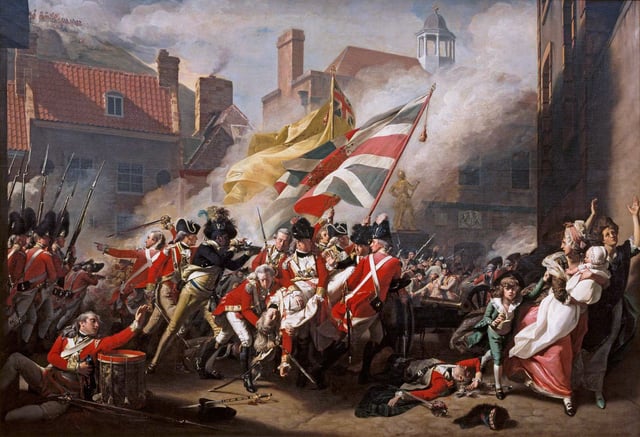
Black Loyalist soldiers fought alongside British regulars in the 1781 Battle of Jersey, from The Death of Major Peirson.
Suppressing a rebellion in America presented the British with major problems. The key issue was distance; it could take up to three months to cross the Atlantic, and orders from London were often outdated by the time that they arrived.[570] The colonies had never been formally united prior to the conflict and there was no centralized area of ultimate strategic importance. Traditionally, the fall of a capital city often signalled the end of a conflict,[571] yet the war continued unabated even after the fall of major settlements such as New York, Philadelphia (which was the Patriot capital), and Charleston.[572] Britain's ability to project its power overseas lay chiefly in the power of the Royal Navy, allowing her to control major coastal settlements with relative ease and enforce a strong blockade of colonial ports. However, the overwhelming majority of the American population was agrarian, not urban. As a result, the American economy proved resilient enough to withstand the blockade's effects.[454]
The need to maintain Loyalist support prevented the British from using the harsh methods of suppressing revolts that they had used in Scotland and Ireland.[573] For example, British troops looted and pillaged the locals during an aborted attack on Charleston in 1779, enraging both Patriots and Loyalists.[574] Neutral colonists were often driven into the ranks of the Patriots when brutal combat broke out between Tories and Whigs across the Carolinas in the later stages of the war.[575] Conversely, Loyalists were often emboldened when Patriots resorted to intimidating suspected Tories, such as destroying property or tarring and feathering.[576][577] The vastness of the American countryside and the limited manpower available meant that the British could never simultaneously defeat the Americans and occupy captured territory. One British statesman described the attempt as "like trying to conquer a map".[578]
Wealthy Loyalists wielded great influence in London[579] and were successful in convincing the British that the majority view in the colonies was sympathetic toward the Crown. Consequently, British planners pinned the success of their strategies on popular uprisings of Loyalists. Historians have estimated that Loyalists made up only 15–20% of the population (vs. 40–45% Patriots)[580] and that they continued to deceive themselves on their level of support as late as 1780.[581] The British discovered that any significant level of organized Loyalist activity would require the continued presence of British regulars,[582] which presented them with a major dilemma. The manpower that the British had available was insufficient to both protect Loyalist territory and counter American advances.[583] The vulnerability of Loyalist militias was repeatedly demonstrated in the South, where they suffered strings of defeats to their Patriot neighbors. The most crucial juncture of this was at Kings Mountain, and the victory of the Patriot partisans irreversibly crippled Loyalist military capability in the South.[322]
Upon the entry of France and Spain into the conflict, the British were forced to severely limit the number of troops and warships that they sent to North America in order to defend other key territories and the British mainland.[234][235] As a result, King George III abandoned any hope of subduing America militarily while he had a European war to contend with.[584] The small size of Britain's army left them unable to concentrate their resources primarily in one theater as they had done in the Seven Years' War, leaving them at a critical disadvantage.[232] The British were compelled to disperse troops from the Americas to Europe and the East Indies, and these forces were unable to assist one other as a result, precariously exposing them to defeat.[237] In North America, the immediate strategic focus of the French, Spanish, and British shifted to Jamaica,[585] whose sugar exports were more valuable to the British than the economy of the Thirteen Colonies combined.[390]
Following the end of the war, Britain had lost some of her most populous colonies. However, the economic effects of the loss were negligible in the long-term, and she became a global superpower just 32 years after the end of the conflict.[586]
United States

1st Maryland Regiment holding the line at the Battle of Guilford

Population density in the American Colonies in 1775
The Americans began the war with significant disadvantages compared to the British. They had no national government, no national army or navy, no financial system, no banks, no established credit, and no functioning government departments, such as a treasury. The Congress tried to handle administrative affairs through legislative committees, which proved inefficient. The state governments were themselves brand new and officials had no administrative experience. In peacetime the colonies relied heavily on ocean travel and shipping, but that was now shut down by the British blockade and the Americans had to rely on slow overland travel.
However, the Americans had multiple advantages that in the long run outweighed the initial disadvantages they faced. The Americans had a large prosperous population that depended not on imports but on local production for food and most supplies, while the British were mostly shipped in from across the ocean. The British faced a vast territory far larger than Britain or France, located at a far distance from home ports. Most of the Americans lived on farms distant from the seaports—the British could capture any port but that did not give them control over the hinterland. They were on their home ground, had a smoothly functioning, well organized system of local and state governments, newspapers and printers, and internal lines of communications. They had a long-established system of local militia, previously used to combat the French and Native Americans, with companies and an officer corps that could form the basis of local militias, and provide a training ground for the national army created by Congress.[587]
Motivation was a major asset. The Patriots wanted to win; over 200,000 fought in the war; 25,000 died. The British expected the Loyalists to do much of the fighting, but they did much less than expected. The British also hired German auxiliaries to do much of their fighting.[14]
At the onset of the war, the Americans had no major international allies. Battles such as the Battle of Bennington, the Battles of Saratoga and even defeats such as the Battle of Germantown[588] proved decisive in gaining the attention and support of powerful European nations such as France and Spain, who moved from covertly supplying the Americans with weapons and supplies, to overtly supporting them militarily, moving the war to a global stage.[589][590]
The new Continental Army suffered significantly from a lack of an effective training regime, and largely inexperienced officers and sergeants. The inexperience of its officers was compensated for in part by a few senior officers. The Americans solved their training dilemma during their stint in Winter Quarters at Valley Forge, where they were relentlessly drilled and trained by General Friedrich Wilhelm von Steuben, a veteran of the famed Prussian General Staff. He taught the Continental Army the essentials of military discipline, drills, tactics and strategy, and wrote the Revolutionary War Drill Manual.[591] When the Army emerged from Valley Forge, it proved its ability to equally match the British troops in battle when they fought a successful strategic action at the Battle of Monmouth.[592]
When the war began, the 13 colonies lacked a professional army or navy. Each colony sponsored local militia. Militiamen were lightly armed, had little training, and usually did not have uniforms. Their units served for only a few weeks or months at a time, were reluctant to travel far from home and thus were unavailable for extended operations, and lacked the training and discipline of soldiers with more experience. If properly used, however, their numbers could help the Continental armies overwhelm smaller British forces, as at the battles of Concord, Bennington and Saratoga, and the siege of Boston. Both sides used partisan warfare but the Americans effectively suppressed Loyalist activity when British regulars were not in the area.[499]
Seeking to coordinate military efforts, the Continental Congress established a regular army on June 14, 1775, and appointed George Washington as commander-in-chief. The development of the Continental Army was always a work in progress, and Washington used both his regulars and state militia throughout the war.
Three current branches of the United States Military trace their institutional roots to the American Revolutionary War; the United States Army comes from the Continental Army, formed by a resolution of the Continental Congress on June 14, 1775. The United States Navy recognizes October 13, 1775 as the date of its official establishment, the passage of the resolution of the Continental Congress at Philadelphia that created the Continental Navy.[593] The United States Marine Corps links to the Continental Marines of the war, formed by a resolution of the Continental Congress on November 10, 1775. However, in 1783 both the Continental Navy and Continental Marines were disbanded.
Intelligence and espionage
Soldiers and sailors
At the beginning of 1776, Washington commanded 20,000 men, with two-thirds enlisted in the Continental Army and the other third in the various state militias.[594] About 250,000 men served as regulars or as militiamen for the Revolutionary cause in the eight years of the war, but there were never more than 90,000 men under arms at one time.
About 55,000 sailors served aboard American privateers during the war.[595] They used 1,700 ships, and they captured 2,283 enemy ships.[451] John Paul Jones became the first great American naval hero, capturing HMS Drake on April 24, 1778, the first victory for any American military vessel in British waters.[596] For example, in what was known as the Whaleboat War, American privateers mainly from New Jersey, Brooklyn and Connecticut attacked and robbed British merchant ships and raided and robbed coastal communities of Long Island reputed to have Loyalist sympathies.[597][598][599]
Armies were small by European standards of the era, largely attributable, on the American side, to limitations such as lack of powder and other logistical capabilities; and, on the British side, to the difficulty of transporting troops across the Atlantic, as well as the dependence on local supplies, which the Patriots tried to cut off. The largest force Washington commanded was certainly under 17,000,[600] and may have been no more than 13,000 troops, and even the combined American and French forces at the siege of Yorktown amounted to only about 19,000.[601] By comparison, Duffy notes that in an era when European rulers were generally revising their forces downward, in favor of a size that could be most effectively controlled (the very different perspective of mass conscript armies came later, during the French Revolutionary and then the Napoleonic Wars), the largest army that Frederick the Great ever led into battle was 65,000 men (at Prague in 1757), and at other times he commanded between 23,000 and 50,000 men, considering the latter the most effective number.[601]
George Washington's roles
General Washington assumed five main roles during the war.[602]
First, he designed the overall strategy of the war, in cooperation with Congress. The goal was always independence. When France entered the war, he worked closely with the soldiers it sent – they were decisive in the great victory at Yorktown in 1781.[603]
Second, he provided leadership of troops against the main British forces in 1775–77 and again in 1781. He lost many of his battles, but he never surrendered his army during the war, and he continued to fight the British relentlessly until the war's end. Washington worked hard to develop a successful espionage system to detect British locations and plans. In 1778, he formed the Culper Ring to spy on enemy movements in New York City. In 1780 it discovered Benedict Arnold was a traitor.[604] The British put a low value on intelligence, and its operations were of poor quality until 1780, when it finally inserted some spies with Congress and with Washington's command. Even then, however, British commanders ignored or downplayed threats that were revealed. The most serious intelligence failure came in 1781 when top commanders were unaware that The American and French armies at both left the Northeast and marched down to Yorktown, where they outnumbered Cornwallis by more than 2 to 1.[605]
Third, he was charged selecting and guiding the generals. In June 1776, Congress made its first attempt at running the war effort with the committee known as "Board of War and Ordnance", succeeded by the Board of War in July 1777, a committee which eventually included members of the military.[606][607] The command structure of the armed forces was a hodgepodge of Congressional appointees (and Congress sometimes made those appointments without Washington's input) with state-appointments filling the lower ranks. The results of his general staff were mixed, as some of his favorites never mastered the art of command, such as John Sullivan. Eventually, he found capable officers such as Nathanael Greene, Daniel Morgan, Henry Knox (chief of artillery), and Alexander Hamilton (chief of staff). The American officers never equaled their opponents in tactics and maneuver, and they lost most of the pitched battles. The great successes at Boston (1776), Saratoga (1777), and Yorktown (1781) came from trapping the British far from base with much larger numbers of troops.[608]
Fourth he took charge of training the army and providing supplies, from food to gunpowder to tents. He recruited regulars and assigned Baron Friedrich Wilhelm von Steuben, a veteran of the Prussian general staff, to train them. He transformed Washington's army into a disciplined and effective force.[609] The war effort and getting supplies to the troops were under the purview of Congress, but Washington pressured the Congress to provide the essentials. There was never nearly enough.[610]
Washington's fifth and most important role in the war effort was the embodiment of armed resistance to the Crown, serving as the representative man of the Revolution. His long-term strategy was to maintain an army in the field at all times, and eventually this strategy worked. His enormous personal and political stature and his political skills kept Congress, the army, the French, the militias, and the states all pointed toward a common goal. Furthermore, he permanently established the principle of civilian supremacy in military affairs by voluntarily resigning his commission and disbanding his army when the war was won, rather than declaring himself monarch. He also helped to overcome the distrust of a standing army by his constant reiteration that well-disciplined professional soldiers counted for twice as much as poorly trained and led militias.[611]
African Americans
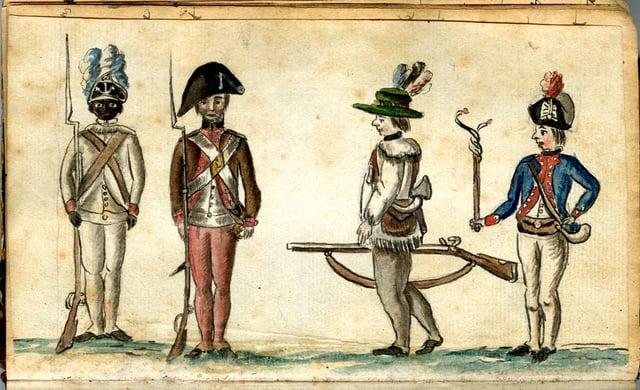
1780 drawing of American soldiers from the Yorktown campaign shows a black infantryman from the 1st Rhode Island Regiment.
African Americans—slave and free—served on both sides during the war. The British recruited slaves belonging to Patriot masters and promised freedom to those who served by act of Lord Dunmore's Proclamation. Because of manpower shortages, George Washington lifted the ban on black enlistment in the Continental Army in January 1776. Small all-black units were formed in Rhode Island and Massachusetts; many slaves were promised freedom for serving. Some of the men promised freedom were sent back to their masters, after the war was over, out of political convenience. Another all-black unit came from Saint-Domingue with French colonial forces. At least 5,000 black soldiers fought for the Revolutionary cause.[612][613]
Tens of thousands of slaves escaped during the war and joined British lines; others simply moved off in the chaos. For instance, in South Carolina, nearly 25,000 slaves (30% of the enslaved population) fled, migrated or died during the disruption of the war.[614] This greatly disrupted plantation production during and after the war. When they withdrew their forces from Savannah and Charleston, the British also evacuated 10,000 slaves belonging to Loyalists.[615] Altogether, the British evacuated nearly 20,000 blacks at the end of the war. More than 3,000 of them were freedmen and most of these were resettled in Nova Scotia; other blacks were sold in the West Indies.[616][617]
American Indians

A watercolor painting depicting a variety of Continental Army soldiers
Most American Indians east of the Mississippi River were affected by the war, and many tribes were divided over the question of how to respond to the conflict. A few tribes were on friendly terms with the other Americans, but most Indians opposed the union of the Colonies as a potential threat to their territory. Approximately 13,000 Indians fought on the British side, with the largest group coming from the Iroquois tribes, who fielded around 1,500 men.[618] The powerful Iroquois Confederacy was shattered as a result of the conflict, whatever side they took; the Seneca, Onondaga, and Cayuga tribes sided with the British. Members of the Mohawks fought on both sides. Many Tuscarora and Oneida sided with the Americans. The Continental Army sent the Sullivan Expedition on raids throughout New York to cripple the Iroquois tribes that had sided with the British. Mohawk leaders Joseph Louis Cook and Joseph Brant sided with the Americans and the British respectively, and this further exacerbated the split.
Farther west, conflicts between settlers and Indians led to lasting distrust.[619] In the Treaty of Paris, Great Britain ceded control of the disputed lands between the Great Lakes and the Ohio River, but the Indian inhabitants were not a part of the peace negotiations.[620] Tribes in the Northwest Territory banded together and allied with the British to resist American settlement; their conflict continued after the Revolutionary War as the Northwest Indian War.[621][622]
Early in July 1776, Cherokee allies of Britain attacked the western frontier areas of North Carolina. Their defeat resulted in a splintering of the Cherokee settlements and people and was directly responsible for the rise of the Chickamauga Cherokee, bitter enemies of the American settlers who carried on a frontier war for decades following the end of hostilities with Britain.[623] Creek and Seminole allies of Britain fought against Americans in Georgia and South Carolina. In 1778, a force of 800 Creeks destroyed American settlements along the Broad River in Georgia. Creek warriors also joined Thomas Brown's raids into South Carolina and assisted Britain during the Siege of Savannah.[624] Many Indians were involved in the fighting between Britain and Spain on the Gulf Coast and up the Mississippi River, mostly on the British side. Thousands of Creeks, Chickasaws, and Choctaws fought in major battles such as the Battle of Fort Charlotte, the Battle of Mobile, and the Siege of Pensacola.[625]
Women
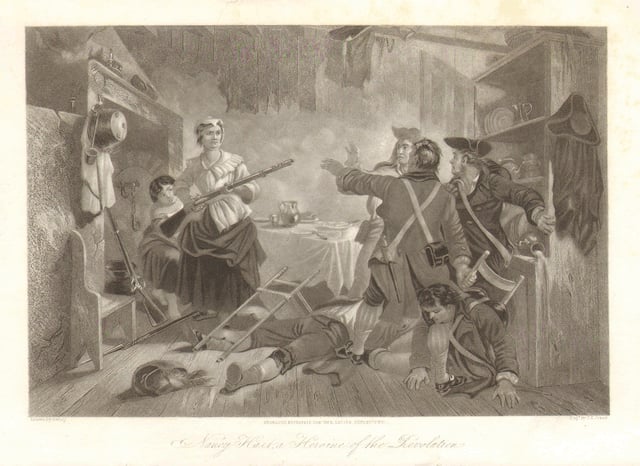
Nancy Morgan Hart captures six British soldiers who had entered her home
A few women fought in the American Army in the war while disguised as men.[626] Deborah Sampson fought until her sex was discovered and she was discharged, and Sally St. Clare died in the war.[626][627] Anna Maria Lane joined her husband in the Army, and she was wearing men's clothes by the time of the Battle of Germantown.[626] According to the Virginia General Assembly, Lane "performed extraordinary military services, and received a severe wound at the battle of Germantown", fighting dressed as a man and "with the courage of a soldier".[626] Other women fought or directly supported fighting while dressed as women, such as the legendary or mythical Molly Pitcher.[628]
Women also accompanied armies as camp followers, selling goods and performing necessary services. They were an official and necessary part of 18th century armies, and they numbered in the thousands during the Revolutionary War.[629] Some women accompanied their husbands when permitted. Martha Washington was known to visit the American camp, for example, and Frederika Charlotte Riedesel documented the Saratoga campaign.[630] Women also acted as spies on both sides of the Revolutionary War.[631]
Race and class
Pybus (2005) estimates that about 20,000 slaves defected to or were captured by the British, of whom about 8,000 died from disease or wounds or were recaptured by the Patriots. The British took some 12,000 at the end of the war; of these 8000 remained in slavery. Including those who left during the war, a total of about 8000 to 10,000 slaves gained freedom.[617] About 4000 freed slaves went to Nova Scotia and 1200 blacks remained slaves.[632][633]
Baller (2006) examines family dynamics and mobilization for the Revolution in central Massachusetts. He reports that warfare and the farming culture were sometimes incompatible. Militiamen found that living and working on the family farm had not prepared them for wartime marches and the rigors of camp life. Rugged individualism conflicted with military discipline and regimentation. A man's birth order often influenced his military recruitment, as younger sons went to war and older sons took charge of the farm. A person's family responsibilities and the prevalent patriarchy could impede mobilization. Harvesting duties and family emergencies pulled men home regardless of the sergeant's orders. Some relatives might be Loyalists, creating internal strains. On the whole, historians conclude the Revolution's effect on patriarchy and inheritance patterns favored egalitarianism.[634]
McDonnell (2006) shows a grave complication in Virginia's mobilization of troops was the conflicting interests of distinct social classes, which tended to undercut a unified commitment to the Patriot cause. The Assembly balanced the competing demands of elite slave-owning planters, the middling yeomen (some owning a few slaves), and landless indentured servants, among other groups. The Assembly used deferments, taxes, military service substitute, and conscription to resolve the tensions. Unresolved class conflict, however, made these laws less effective. There were violent protests, many cases of evasion, and large-scale desertion, so that Virginia's contributions came at embarrassingly low levels. With the British invasion of the state in 1781, Virginia was mired in class division as its native son, George Washington, made desperate appeals for troops.[635]
See also
Bibliography of the American Revolutionary War
Bibliography of George Washington
Bibliography of Thomas Jefferson
Commemoration of the American Revolution
Diplomacy in the American Revolutionary War
British Army during the American War of Independence
First Treaty of San Ildefonso
First League of Armed Neutrality
Fourth Anglo-Dutch War
George Washington in the American Revolution
Intelligence in the American Revolutionary War
List of American Revolutionary War battles
List of British Forces in the American Revolutionary War
List of Continental Forces in the American Revolutionary War
List of infantry weapons in the American Revolution
List of plays and films about the American Revolution
List of revolutions and rebellions
Naval operations in the American Revolutionary War
Treaty of El Pardo (1778)